Introduction by Jean Miyake Downey and Rebecca Dosch-Brow
Chisato (“Kitty”) Dubreuil, an Ainu-Japanese art history comparativist, has charted connections between the arts of the Ainu and those of diverse indigenous peoples of the north Pacific Rim. Currently finishing her PhD dissertation, Dubreuil co-curated, with William Fitzhugh, the director of the Smithsonian Arctic Studies Center, the groundbreaking 1999 Smithsonian exhibition on Ainu culture. Insisting on the inclusion of the work of contemporary Ainu artists, as well as art and artifacts of past Ainu culture, her input redefined the scope of the exhibition and reflected her ongoing activism to challenge the “vanishing people” myth about the Ainu. Dubreuil explains, “We are still here and our culture is still vibrant.”
Dubreuil, with Fitzhugh, co-edited Ainu: Spirit of a Northern People, published by the Smithsonian in 1999, a critically acclaimed volume of interdisciplinary contributions by scholars of Ainu issues. Library Journal described the volume as “the most in-depth treatise available on Ainu prehistory, material culture, and ethnohistory.”
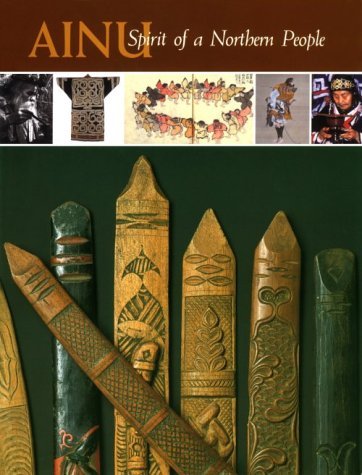
Fig. 1: This is the most comprehensive, interdisciplinary book ever published on the Ainu in English or Japanese. It has 415 pages and over 500 illustrations.
Her second award-winning book, From the Playground of the Gods: The Life and Art of Bikky Sunazawa, introduces the innovative visual artist and Ainu activist who led the “break out” of Ainu art from the tourist market into global fine arts, during a period of worldwide transformations of indigenous arts.Dubreuil’s fascinating account includes details of Sunazawa’s involvement in Japanese avant-garde circles of the 1960’s, when he became friends with originator of Ankoku Butoh, Hijikata Tatsumi, and the famous writers, Shibuzawa Tatsuhiko and Mishima Yukio.Rising to prominence in the 1970’s and 1980’s, Sunazawa helped to develop a powerful and creative reflection on Ainu identity, bridging the Ainu’s rich historical legacies with contemporary political concerns, and drawing inspiration from the work of his mother, one of the most respected textile artists of the twentieth century, and also indigenous art from the Northwest Pacific Coast.
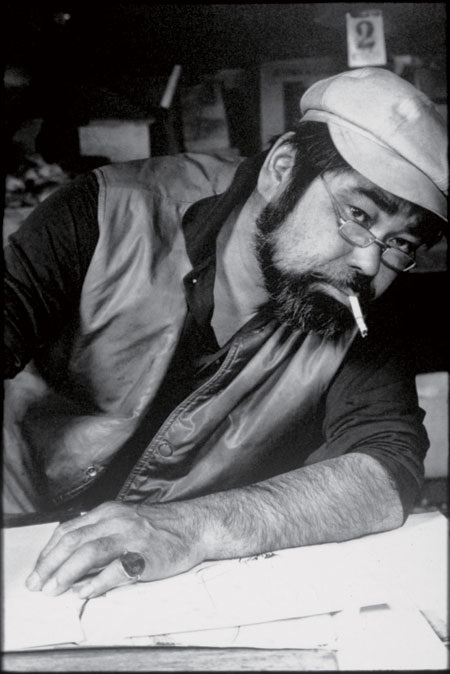
Fig 1 A: Bikky Sunazawa (1931-1989).
Dubreuil has also ventured into literary nonfiction, with an essay paying tribute to Bikky Sunazawa’s mother, Peramonkoro Sunazawa, included in Sky Woman: Indigenous Women Who Have Shaped, Moved or Inspired Us, an anthology of indigenous scholars, artists, writers from across North America, Mexico, Pacific Islands and Japan. It was published in 2005 by Native Women in the Arts, a Canadian organization that promotes the renewal of indigenous cultures.Dubreuil describes the impetus of this work: “The premise of this anthology was to pay honor to specific indigenous women who touched our lives in a special way. I was fortunate to have Peramonkoro as a role model to help me along the way. I suspect my story is different than the other authors in the book in that I never met her. It was through her that I became extremely interested in her son Bikky Sunazawa.”
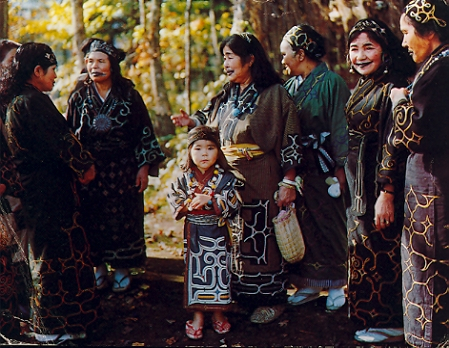
Fig. 2: The woman in the center is Bikky’s mother, Peramonkoro with his daughter, Chinita, circa. 1965.
A Note to the Reader
The above introduction by Jean Miyake Downey and Rebecca Dosch-Brown was for an interview article entitled “Ainu Art and Culture: A Call for Respect,” that appeared in Kyoto Journal, (no.63, 2006), a widely respected English language journal dedicated to issues in Asia. I am Ainu, and my areas of study are the arts and cultures of the indigenous peoples of the North Pacific Rim.
I was first contacted by Jean Miyake Downey, an attorney dedicated to indigenous rights, in the early fall of 2005 to gauge my interest in a person-to-person interview on Ainu issues.She started our conversation by saying that she had been following my career working on Ainu issues for ten years.My ego properly attended to, I accepted the interview.The interview was to include Rebecca Dosch-Brown who was teaching at the Hokkaido University of Education in Asahikawa, Hokkaido.Asahikawa is the home of the Chikabumi Ainu, and she had developed a great interest in the Chikabumi.
As a setup for the interview and to gather information for the brief introduction, and to identify areas for the interview, Dosch-Brown left the frozen environs of Asahikawa to visit me in the comparatively balmy city of Sapporo.The upshot of the meeting was that Downey was finding a problem getting away from her home in Florida and we would have to do the interview via e-mail. I welcomed the idea for a written interview as it would allow me time to think in greater depth.
The Kyoto Journal gave us a great deal of space for the interview, plus a reprint of my short story, “Her Name is Peramonkoro!” and a review of my book, From the Playground of the Gods: The Life and Art of Bikky Sunazawa. Because so little is known about the Ainu, my inquisitors covered many topics, which required my answers to be more concise than I wished.
Early in 2007 I was contacted by Mark Selden of Japan Focus and asked if I was interested in developing the original article. Knowing that this was a great opportunity, I eagerly accepted.
Because I have published frequently on the Ainu and have given many papers internationally, both Downey and Dosch-Brown had thought my professional life was centered solely on Ainu issues, when actually the majority of my recent academic studies and research have been on the indigenous peoples of the Northwest Coast of Canada and Alaska. Keeping the original questions of Downey and Dosch-Brown, I have expanded my answers dramatically, often comparing the Ainu culture with the Indian cultures of the Northwest Coast. When I first did the interview for Kyoto Journal, we, my husband and I, had recently returned to Hokkaido after an absence of 20 years, and were basically living off the land, a most difficult task during sub-arctic winters. My time in Japan provided an opportunity to see and reflect on the changes of the past twenty years in both the Ainu and Japanese cultures. We subsequently returned to North America in the middle of 2006. Before our move to Hokkaido, we had returned several times to Japan in our search for the perfect bowl of ramen, and for family and research reasons of more then four weeks each, but it simply does not equate to living in the culture. My current free time has allowed me to pick and choose from general project offers. Without a doubt, this reexamination was time well spent.
Chisato O. Dubreuil
**************************************************************************
The Origins of the Ainu and their Culture
JD/RD: The Ainu have been depicted as “mysterious proto-Caucasians” unrelated to Japanese people. However, DNA research shows that Ainu are the direct descendants of the Jomon, the ancient people who created Japan’s first culture and one of the world’s oldest extant potteries. This means that the Ainu and present-day Japanese are biologically related. Would you comment?
KD: The findings were only new to those who wanted to cling to the myth of a lost Caucasian tribe. Some anthropologists have reluctantly supported the theories that came into question because of DNA evidence. True scholarship is open to change, and the advent of DNA research was threatening for some. Other anthropologists knew DNA would revolutionize the field, and were excited by what that might mean. What has been done so far is only the beginning. I don’t think that it is an exaggeration to compare DNA with finding out that the world isn’t flat.
Clearly DNA is the most recent pathway to ‘truth,’ but it’s not the only way to find connections to the past. A few Ainu, including myself, and even fewer freethinking Japanese anthropologists, had already looked at the art of the Jomon as it pertains to the Ainu of long ago. (The word ‘Jomon’ has become an all-inclusive word for early cultures in what is now called Japan; for convenience, I will also use this generic term). When most people think of Jomon, it is their pottery that first comes to mind, especially the highly imaginative vessels with designs made with twined cords. Through research I have found that many of these designs are remarkably similar to traditional Ainu designs. More important to my work are the lesser-known Jomon humanoid clay figurines that featured Ainu style clothing with Ainu-like designs, also placed where they are found on traditional Ainu robes.

Fig. 3: Ceramic figurine found at the Motowanishi site near Muroran, Hokkaido. It has been dated to 700 – 400 BC, from the Final Jomon period.
While DNA evidence makes the Jomon/Ainu relationship clear, the arts of any indigenous group are their visual literature. DNA findings have validated the belief of art historians that the combined age of Ainu/Ainu art makes it one of the longest continuous art traditions in the world. Of course DNA is not the final answer; future study of the history of art and culture must be based on a multi-disciplinary approach. Lastly, the DNA findings throw into dispute the arbitrary assigning of the date of origin of the Ainu as the 14th century BCE. Worse, many archaeologists have put the Okhotsk, Satsumon, and Epi-Jomon cultures in separate categories, even though the art, spiritual beliefs and ceremonies appear the same. More research, especially in the areas of the arts, and more DNA, will, I believe, lead to the reasonable conclusion that there were no cultural disconnects, making the Ainu culture older by more than 10,000 years.
JD/RD: What are some other misconceptions about the Ainu?
KD: I am always amazed at the number of Japanese who believe in mythological origins of the Ainu, the most prevalent being that we evolved from dogs. If it weren’t so serious it would be
funny. People who are into discrimination will always find reasons to fit their beliefs to their prejudices, however ridiculous the reasons.
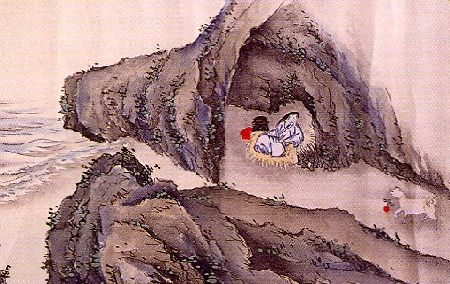
Fig. 4: This Ainu-e (literally means paintings of the Ainu by Japanese), was painted by Murakami Shimanojo in Curious Sights of Ezo Island (1799). It depicts one of several origin myths of the Ainu. Japanese children still taunt Ainu children by chanting, “Ainu are dogs.” Children do not think of discriminatory taunts by themselves, they learn from adults.
Another origin myth that is losing credibility is the belief that the Ainu are some kind of lost tribe of Caucasians. The myth was created by early European scholars from the mid-nineteenth century, and because this was a respected view of Europeans, the myth can still be found as fact in some textbooks and reference books. There is some legitimate basis for the ‘mistake.’ The Ainu of the period looked nothing like the Japanese. The Ainu were muscular with skin tones similar to the darker French or Italians. They were very hairy, with thick and wavy hair, luxurious beards, and abundant body hair. Eye color was mostly brown, but could be ‘bluish’ or ‘greenish,’ no doubt a Russian influence. Most importantly, the very young were reported not to have the Mongolian ‘blue’ spot on their lower back. Today, because of intermarriage with the Japanese, the above features are not always present, but I have very thick wavy hair and in the summer I get a very dark tan, my eyes have a more European look, and my body build is somewhat muscular. For all these reasons during my youth I was subject to verbal taunts of “dojin.” While the dictionary meaning is “native,” it is often used as a pejorative term.

Fig. 5: Early visitors to ‘Ainu country’ had reason to question the origin of the Ainu. This picture from the 1860s is of an Ainu mountain hunter from Hokkaido.
One very important misconception is about the bear, the god of the mountains. Some people think that because the bear is ceremonially killed in the “iyomante,” the spirit-sending ceremony, it is a sacrifice to god. IT IS NOT! We believe that the bear IS a god spirit, disguised as a bear (or other living thing), who comes to the people with its gifts of food and fur. The death of the bear releases the spirit, allowing it to return to god’s land. I have been asked about my use of the term “god’s land” as opposed to the most familiar term “the land of the gods”? For us, “god’s land” refers to land belonging to the gods, whereas “land of the gods” suggests a more transient quality. We believe that the use of the term eliminates any ambiguity as to the proprietorship of god’s land.

Fig. 6: Bear ceremonially killed to release its god spirit. To prepare for the journey to god’s land, the bear is given food such as the salmon shown in the foreground. The huge medallion in front is part of a traditional tamasay (necklace) with large glass beads. The necklace identifies the bear as a female. A male bear would be identified with a sword. The sex of the bear has no bearing on matters of any kind.
The spiritual beliefs of the Ainu are complex, they do not fit the usual definition of animism, nor are they a form of Shinto. Kamuy-mosir, the Ainu land of spirits is on a separate track parallel to the human land (Ainu-mosir). There is a different relationship between god spirits and humans. Kamuy (gods) send good or bad gifts to humans depending on how humans treat the gifts of the gods. It is important to understand that we do not worship nature per se. All things in nature are spirits sent to Ainu mosir disguised as bears, trees, wind, etc. There is a big difference between what traditional Ainu believe and those who follow Shino beliefs. Traditionally all Ainu activities were based on respect for the gods. If humans were not respectful, the evil gods (wen-kamuy) would wreak havoc on the people. An easy example; if a village is respectful to kamuy, they would get soft gentle rains for their small gardens, if not, they would be visited by a hundred year flood. Wen-kamuy is very resourceful, and not to be taken lightly. Today most Ainu are Buddhists with a good measure of Ainu belief systems thrown in. There are some Ainu who are Christians, mostly among the Asahikawa Ainu.
JD/RD: The most accepted theory of migration is that the Ainu came from the northern route into Japan. So are the Ainu also a North Pacific people, related to native people from the northern Pacific Rim and adjacent Bering and Chukchi Seas? Do you see evidence of connections reflected in their arts?
KD: I have not seen DNA research comparing Chukchi Eskimo or other peoples of the North Pacific with the Ainu. Given that there has been mutual contact for thousands of years, I am sure that DNA evidence will show that all North Pacific peoples are part of an extended family.
People often ask me if the peoples of the Northwest Coast of the Americas are related.
I strongly believe that we are, but I don’t see what many people consider similarities between Ainu designs, and Northwest Coast carving designs found on house posts, totem poles, or shaman rattles, and designs on ceremonial regalia such as tunics, aprons, leggings and Chilkat blankets. Traditional Northwest Coast designs are not spiritual in the usual sense. Instead, they are mostly signs of social status and ancestral connections, usually related to members from the animal world that became family crests owned exclusively by the individual or family. These ‘rules’ still apply.
The animal itself could represent a spirit. For example, a totem pole is not a ‘religious’ symbol, but the images on it could be, especially with the Tsimshian. This is a new area of research for me. In contrast all Ainu art was made to please the gods (kamuy), but the art could never be made in the image of any of the spiritual gods except for special ceremonial items.
If that’s the case why do we see the ubiquitous Ainu carved bear, the god of the mountains, kimun-kamuy, wherever tourist items are sold? After we lost the wars of the 19th century, the Japanese outlawed fishing and hunting, our main source of food, and many Ainu starved to death. By 1900, our traditional way of life, based on hunting and fishing, was mostly gone. Unique to our beliefs is our relationships with kamuy, if we believe that we have been wronged, we can petition, or even argue with the gods for change. In this case we petitioned the gods through private prayer that we be allowed to change the dogma against making images in the form of gods. We desperately needed to enter the market, and gradually the “Ainu bear” and other animal gods, especially the salmon, kamuy-chep (god’s fish) were carved and offered for sale. Of course, we continue to carve kamuy figures on our most sacred ceremonial item, the ikupasuy, our prayer-sticks, which enable us to communicate directly with the gods.

Fig. 7: The carved bear is the most popular ‘souvenir’ among tourists who travel to Hokkaido. This bear, carved by Ainu artist Matsui Umetaro, is from the 1920s. In 1938 he was chosen to carve a bear for Emperor Hirohito. Unfortunately the overwhelming number of these ‘kanko kuma’ (tourist bears) are not carved by Ainu.

Fig. 8: This sacred ikupasuy (prayer-stick) depicts kimun-kamuy (the god of the mountain) and chep-atte-kamuy (the salmon god). It may have been used for the First Salmon ceremony.
JD/RD: Some people say traditional Ainu designs are so abstract, no one can detect what they represent, while others believe that they see animals such as owls or bears in them. Could you comment further?
KD: Neither is true. First, there isn’t anything to detect in Ainu designs. As stated we believe that the evil gods (wen-kamuy) are so clever that if there was something ‘hidden’ in the design, they would know, and they could enter the image and cause great harm. The beautiful art on the clothes, platters, etc. is our way of honoring and respecting the gods, but the designs are not spiritual in any way. Importantly, tradition dictates that all designs be original. To make a ‘reproduction’ would be disrespectful to kamuy. When looking at a robe, the designs may look the same, but each is different, although admittedly the design differences may be subtle. Part of the problem is the subtle differences between design elements; for example, eight out of the nineteen design elements identified are variations of the whorl.
I do see a possible challenge to design diversity. There are Ainu dance groups that have similar dance robes such as the Asahikawa Chikabumi ‘style,’ the chijiri. They do all look alike, but as I stated, there can be minor differences. I have never had the opportunity to have all robes together to inspect. The designs are too complex to compare individually. Also, it is often reported that all designs on robes are symmetrical. While most are, my research has shown that approximately 15-20 percent are asymmetrical.

Fig. 9: A good example of asymmetrical design. All styles of robes have at least some examples of asymmetrical designs. However, most examples are much more subtle.
Northwest Coast designs are a bit easier to read, sometimes. For example, certain designs such as bears can be identified, but other designs on the bear can be very difficult, for example, frogs coming from the eyes, or wolves on sea bears, both very abstract. More difficult are design elements known collectively as “formline designs.” The known individual elements have been given names such as Ovoid, Tertiary-S, U-form, Split-U, the Salmon-trout’s head, and negative and positive space. Each design element may have countless variations. We don’t know the Native terms for the elements if in fact there were Native terms.

Fig. 10: One side of a contemporary bentwood dish by Tsimshian artist Lyle Wilson. Following the design of a very early dish, “it seems that the greater the masterpiece in Northwest Coast art the less we can say about its meaning” (Wilson Duff, 1983). I believe the simple designs on the Jomon figurine featured in figure 3 are forerunners of modern designs, but could the complex Ainu designs of today come from the spirit world of the Jomon, or from the Northwest Coast, or did the Jomon/Ainu influence the Northwest Coast cultures? We just don’t know.
Historically, other possibilities for east-west artistic influences existed through personal contact or through trade ‘brokers.’ My research reveals oral narratives on both sides of the North Pacific that tell of early contact with each other. Based on interviews of Ainu and Northwest Coast elders from the Tlingit area (now southern Alaska), the Aleutian Islands seem to have been the most logical trans-Pacific route for the Ainu, Aleut and Tlingit peoples. The Aleutian people, neighbors of the Tlingit, certainly traveled east and west, and they no doubt traveled to Kamchatka where the Kamchatka Ainu lived. We know with certainty that the Aleut and Ainu were forced by the Russians to trap sea otter together in the Kuriles in the 1700s, but the big question is, was there earlier contact?
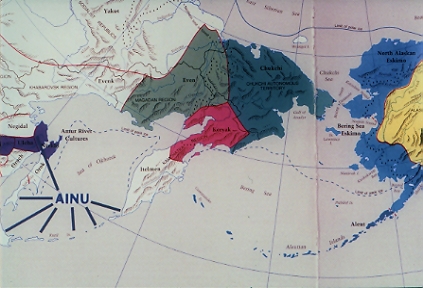
Fig. 11: As this map indicates, the total territory of the Ainu was huge with a much smaller land mass. As maritime traders, they traveled great distances. The fact that there are oral traditions referring to early Tlingit/Ainu contact is exciting.
There is also some physical evidence. An engraved bone needle case was found from the Okhotsk culture (ca. AD 500), with designs very similar to those on early Tlingit Ravenstail robes (ca. 1750-1800). The designs are also similar to the tattoo designs historically found on the backs of hands and forearms of Ainu women. Admittedly the physical evidence is thin, but with more research, we may find new links to the past.

Fig. 12: Needlecases and the needles they contained were very important to the women fashion designers. This Okhotsk case, circa 500 AD, was found in northern Hokkaido. Other needle cases with geometric designs have been found on Shikotan, one of the disputed islands claimed by both Russia and Japan. I have no doubt that other objects from the Kurile islands have similar designs and are in Russian collections.
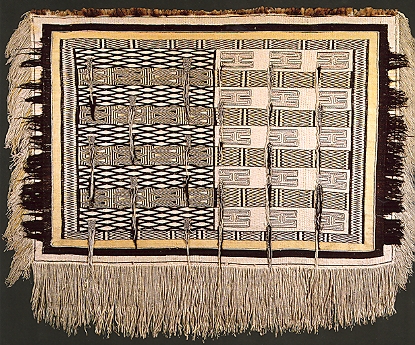
Fig. 13: The needlecase described in figure 12 has a design similar to those found on Tlingit Raven’s Tail robes. This robe was made circa 1750-1800. Due to climate and weather conditions, older robes are extremely rare with most discoveries being remnants.

Fig. 14: Tattoos of similar design such as those shown in figures 12 and 13 were common on the backs of hands and forearms of Ainu women well into the first half of the 20th century.
I mentioned oral traditions. Unfortunately, oral narratives in their many forms including but not restricted to stories, songs, and dances, have received little respect. Importantly that is beginning to change among some indigenous groups as shown by the 1997 Supreme Court of Canada decision, Delgamuukw V. British Columbia. In this case the Supreme Court found in favor of the Gitxsan and the Wet’suwet’en tribes in their land claims against British Columbia. The High Court stated that future courts must accept valid Native oral history as evidence, and this will undoubtedly be a key ingredient in future land claim cases. At the time of this writing I am not suggesting that the Gitksan have won the land claims, but their case and future cases must take into account oral histories. The obvious question is how a Canadian ruling affects the Ainu. In the short term probably little, but the ruling is the first on the North Pacific Rim to accept evidence from oral history of an indigenous people, and it could act as a worldwide precedent.
Japan has often responded to international pressure, and now might be the time. The first order of business is to search for any evidence that could support Ainu claims. For example, the eminent Japanese scholar Tanimoto Kazuyuki has been researching the music and dance of Northern Pacific peoples for many years. His research is not based on a specific agenda, but rather seeks to record all these oral histories in dance and song form before they are lost. The late Donald L. Philippi spent years researching traditional yukar (Ainu oral narratives). A fresh look at both his material, and Tanimoto’s, could be especially important as it pertains to legal issues of the Ainu. There is one thing for sure; the Ainu will never cease their fight to reclaim their ancestral lands. I firmly believe that oral histories will aid our peoples. Another thing for sure is that the fight is not going to be easy.
JD/RD: Many people think of not only the Japanese, but also the Ainu as “homogeneous.” Yet haven’t the Ainu always been diverse?
KD: Today when the word “Ainu” is used, many people assume you mean Hokkaido Ainu, and that all Hokkaido Ainu communities are the same. Actually there were Ainu groups in Honshu such as the Tohoku Ainu, but there were also the Sakhalin Ainu, Kurile Ainu, Kamchatka Ainu, and the many Hokkaido groups, some of which either merged with other Ainu groups, or were assimilated in the wajin (Japanese) culture in Hokkaido. The Ainu ‘groups’ were not generic. Besides language differences, there were other differences including ceremonies, fashion, food, housing, dance, and oral histories. Even the major gods are different, depending partly on environmental differences. For example, in all physical environments of the Ainu that can support the bear, the god of the mountain, the bear is the major god. The Kurile Islands, on the other hand, did not have an environment in historical times that supported a bear population. The surrounding waters, however, support a very healthy population of orca whales (killer whales). The killer whale, the god of the ocean, is a major god equal to the bear. Interestingly, the Kurile Ainu, closest to Hokkaido, would occasionally trade for a cub bear for the iyomante, the bear-sending ceremony.
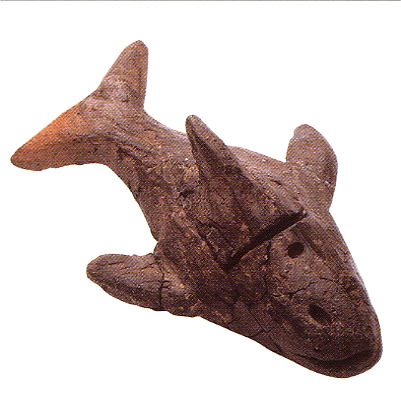
Fig. 15: The Jomon appear to have honored the same spirit animals as the Ainu. Killer whale from the middle Jomon period, 3,000 – 2,000 BC, found at a site in Hakodate, Hokkaido.
Today a very few Ainu claim to be pure blood Ainu. I am certainly not going to argue those claims, but pure blood Ainu would be extremely rare. We have been in social contact with other peoples for thousands of years. The biggest influence initially would have been other Native groups such as the Nivkhi and Orok on Sakhalin Island. The next major influence would have been Russians and later Japanese. Lastly, because the Russians forced the Aleut and the Kurile Ainu to work together harvesting sea otters in the early eighteenth century, there was bound to be genetic exchange.
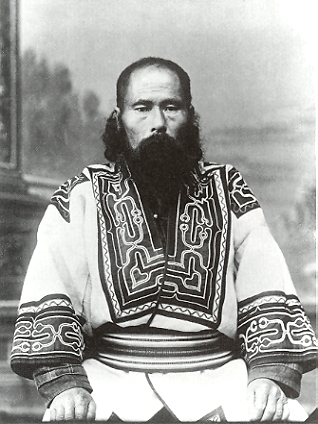
Fig. 16: Bronislaw Pilsudski, a Polish prisoner of the Russians, took this picture of a wealthy Sakhalin Ainu man around 1905. Identified as a mixed blood Ainu/Russian, the bold designs on his robe, typical of Sakhalin robes, indicate the ready availability of fabrics that the Hokkaido Ainu could never afford. Notice the belt, a clear sign of prosperity. While the Sakhalin Ainu had a separate dialect, they had no problem communicating with Hokkaido Ainu as suggested by the number of intermarriages.
While many cultural differences continue, today some of the biggest differences are political. Unfortunately this has led to a lack of cohesiveness on major issues. Sometimes we are our own worst enemy. This is not only an Ainu problem: I know of no indigenous group that hasn’t experienced the problem of cultural division.
JD/RD: Do you think there are any Ainu left in the areas you mentioned?
KD: Most Japanese scholars believe that there are no “Ainu” in the Kuriles, Kamchatka, or Sakhalin. I totally disagree. There is absolutely no question that there are not only high numbers of mixed blood Ainu/ Russian people, and mixed blood indigenous and Ainu; and there is no doubt that there are at least some Japanese/Ainu in Sakhalin. It defies logic to think otherwise.
The Ainu, Russians and many ethnic groups were in social contact for centuries. We may never know the extent of Ainu contact, but it’s sure to be considerable. Many people do not know or have forgotten that the Ainu were an entrepreneurial maritime trading people who traveled great distances in the pursuit of business in the Ainu ocean-going canoe, the itaomachip. There are reports that by 1739, and perhaps much earlier, Ainu leaders had some Ainu live among their trading customers to learn their languages and customs to facilitate trade. The people of the North Pacific, not just the Ainu, traveled incredible distances. If the reader has the opportunity to go to New York City, I recommend going to American Museum of Natural History to see the huge Haida Canoe on display. After seeing it, there can be no doubt of long distance travel.
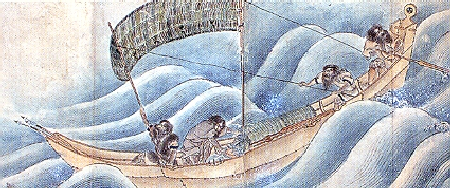
Fig. 17: Maritime travel required a sailing itaomachip (canoe). The trees on any of the Ainu islands were not as big as they are on the Pacific Northwest Coast. Innovation by Native peoples was necessary to compete in the Native maritime economy. To make a ship large enough to conduct business safely, the hull started as a dugout canoe, planks were then split from logs and laced to the hull ‘lapstreak’ style. In 1887, Romyn Hitchcock doing research in Hokkaido for the Smithsonian, measured an itaomachip that was 50 feet long with a 10-foot beam.
JD/RD: Some scholars think that the ancient Kennewick man, whose bones were found in Washington State, was an Ainu. What’s your opinion?
KD: The story of Kennewick Man with its intense legal fighting by several Indian tribes with their ‘allies,’ the affected federal, state, and local government agencies, against the scientists, is so complex, I think a little background is needed. In July 1996, two college students found some human bones on the banks of the Columbia River in Kennewick, Benton County, Washington, which is in the southeastern part of the state. The students led police to the find, and the police called forensic anthropologist James Chatters and took him to the site. Immediately Chatters knew the bones were old, but had no idea how old. Not only were they old, it did not appear that they were the bones of an American Indian. Chatters and a colleague, Catherine MacMillan, a physical anthropologist, were convinced that it was a white person. MacMillan closely examined the skull and other bones and declared that the bones were of a Caucasoid male from forty-five to fifty-five years at death. They had the pelvic bone Cat-scanned and found a stone spear point embedded.
In August samples from the bones were sent to the University of California, Riverside for radiocarbon dating, and the results were astounding! Kennewick Man, as he was now named, was approximately 9,300 years old with a 95 % confidence level. The news of the discovery and its age certainly raised the excitement level in the scientific community, but most especially it raised to a fever pitch the ire of every Indian group in the area, including the Umatilla Indian tribe in Oregon. They believed that Kennewick Man was an Indian, and one of their ancestors. Supporting the Umatilla position were the Army Corps of Engineers, which had oversight of the federal land where the discovery was found. The Umatilla were very unhappy that the bones had been sent to the University of California, Riverside. The Umatilla called the other tribes of their confederation which consisted of the Yakima, the Wanapum band of the Yakima, the Confederate Tribes of the Colvilles, and the Nez Perce, strongly pressured the Army Corps of Engineers, who were working from the Indian perspective, to repatriate Kennewick Man for reburial under the Native American Graves Protection and Repatriation Act (NAGPRA). Soon the US Department of Justice and the US Department of the Interior also backed the Umatilla et al. position using NAGPRA.
Immediately the tribes denounced Chatters and his supporters, which now included scientists from the Smithsonian and other academics, accusing them of grave robbing, and holding them liable for violations of the Archeological Resources Protection Act (ARPA). In sum, the tribes wanted to bury Kennewick Man with no scientific research on the bones as quickly as possible. At the same time Smithsonian scientists and several university anthropologists wanted the bones for research without the cumbersome restrictions of NAGPRA. Everyone knew if Kennewick Man were buried with the Umatilla ceremonial rituals, retrieval of the bones for scientific research would be extremely difficult if not possible. Now led by Douglas Owsley from the Smithsonian’s National Museum of Natural History, a lawsuit was filed in September 1996, and after two years of intense legal wrangling, the plaintiffs won the right to continue to examine the bones. The strongly worded seventy-six-page judgment from the U. S. District Court in Oregon, came on August 30, 2002. The bones of Kennewick Man are now housed at the Burke Museum on the campus of the University of Washington in Seattle, Washington. Most importantly, the victory established precedent for any discoveries of a similar nature in the future. Cracking NAGPRA was truly unexpected.
It was the early research on the ethnicity of Kennewick Man that was called into question. From the beginning James Chatters and other physical anthropologists strongly believed that the bones were not of an American Indian. The tribes fought back using oral histories on the origin of the Umatilla. Owsley, et al. then used the oral histories against the tribe! The scientists were able to prove the bones were much older than the oral histories of the earliest American Indian in the area, thousands of years older. Clearly the Indian oral histories were the most important part of the scientists’ case. The court agreed with the scientists.
The possible Ainu connection seems to have first surfaced in July of 1996, in a hypothesis brought forth by Richard Jantz from the University of Tennessee. Supporting Jantz was C. Loring Brace of the University of Michigan, who, having seen a picture of Chatters holding Kennewick Man’s skull, believed that the skull was Ainu in appearance. (However, given the age of Kennewick Man, to call it an Ainu would be a misnomer. It should be recognized as having ‘Jomon’ heritage.) Doug Owsley, perhaps the most respected bone scientist in North America agreed that this was a definite possibility, but these scholars also offered other possibilities: that Kennewick Man could be an Easter Islander, Moriori, or a Polynesian. For whatever reason these and other possibilities were rarely mentioned in the press. The possibility that Kennewick Man could be Ainu was advanced by an article in the December 2000 issue of National Geographic, which had a two page spread featuring Kennewick Man. It’s hard to question the top bone man, from one of the best museums in the world, about the quotes in one of America’s most respected magazines. No one said the Kennewick Man was absolutely Ainu, but no other group was mentioned.

Fig. 18: The bust is based on the skull of Kennewick man. Identified as Ainu by some researchers, the skeleton was carbon dated to be 9,300 years old. At that age, the label of ‘Ainu’ is incorrect. To be that old, Kennewick man would be Jomon.
My husband and research partner David interviewed Chatters several times while we were at the Smithsonian. While the age of Kennewick Man is incredible, it is the ethnicity that is extremely important. Could Kennewick Man actually be Ainu/ Jomon? Based on my research, while improbable, I believe it’s certainly possible. If so he most probably came from the Kurile Island Ainu, or from the Kamchatka Ainu. He had the means to reach the Northwest Coast by a large canoe via the Aleutian Islands, a much more probable route than going by the Bering Straits. He could have then traveled south along the coast to what’s now Washington State and then moving upstream on the Columbia River to what is now Kennewick, Washington. Given the location of where Kennewick Man was found, it is interesting to me that no one, on either side of the issue, or the press, questioned where he actually died. He could have died near any river hundreds of miles east and his body carried by waters that emptied into the Columbia. This would be especially true if he died in spring when the rivers were at their swiftest. Of course, it would not have been in the best interest of either litigant to raise the issue, especially the tribes.
Unfortunately, the U.S. government’s actions made DNA identification most difficult if not impossible. For example, after Chatters was forced to give up the bones, some of the bones, under security of the various governments began to disappear. Some were stolen such as most of both femurs, but others were lost or destroyed by government researchers, these include parts of a tibia, a few ribs, and several hand and foot bones. Any loss of bone is inexcusable. There were those who believed that Chatters had stolen the bones, but there was no proof. Chatters and others working with him were pressured by the Federal Bureau of Investigation (FBI), and at least one person had to take a lie detector test. Chatters’ later behavior supported his innocence. For two years after the find, Chatters would walk the riverbank where the bones were found. He found more bones and gave them to government officials as required by court order.
Because of the importance of identifying who Kennewick Man ‘was,’ Chatters and others of the Smithsonian team who went to court, pressed the government on the subject of DNA. There are still a great many bones that would have good DNA properties. The fact that DNA testing has not taken place is not a technology problem; the technology needed for extraction of DNA from aged bones has been available for several years. The problem lies with the U.S. government agencies. Not only did the government drag their feet, using a helicopter and a crane they ordered hundreds of tons of rock and soil to be dumped on the site, and immediately planted many fast growing Russian Olive trees. The site was buried! No more Kennewick Man bones were to be discovered!
The question here is why were the various government agencies, including certain parties in the White House, so determined to turn Kennewick Man over to the Umatilla? Why did they ignore the scientific evidence? Why did they make DNA testing impossible? The government knew the age of Kennewick Man was beyond reproach, and that he was not Native American. It is our opinion, if Kennewick Man was proven to be Ainu, or any other non-American Indian, the basis for all ‘Native American’ treaties, would be under assault. The title, Native American, would no longer apply. My husband, part Mohawk and part Huron, believes strongly that all treaties would be in jeopardy, and the ‘Indian fighters,’ the people who are always trying to break Indian treaties, would bring hundreds if not thousands of law suits, legal actions that the Indian tribes would be ill prepared to fight. By claiming Kennewick Man should be under NAGPRA, the status quo would be maintained. Clearly it was in the tribes’ interest to fight for NAGPRA. Even though the problems are incredibly complex, at some point I believe Kennewick Man’s DNA will identify his origin and will be leaked to the public, which will lead to dire consequences. The story is too great to remain a secret.
Aside from the problems facing Native Americans, what if Kennewick Man is Ainu/Jomon, how would it affect today’s Ainu? Immediately interest in the Ainu would multiply a thousand fold around the world, but most especially by the Japanese government. All of a sudden the Ainu would be “National Treasures,” and the Ainu would reign supreme. This puts the Japanese in America very early, and would make for interesting changes in historical understanding. Even more interesting is a question that no one is asking. If Kennewick Man is Ainu/Japanese, is it credible to think he came to North America alone? I believe it would be physically impossible. This is no longer a rhetorical question. While there is a huge time difference, the work of Grant Keddie or George I. Quimby has shown that damaged Japanese ships were blown off course by ocean storms and landing in America and Canada in the early nineteenth century. While this discovery is important, the ‘landings’ were rare, unpredictable events. As I have suggested in earlier publications, I believe the east-west travel by Ainu and Aleuts using the Aleutian Islands as stepping-stones was a common occurrence. In any case, for those of us who believe in early indigenous trans-Pacific travel, it’s an exciting thought.
JD/RD: You insisted that the 1999 Smithsonian exhibition on the Ainu that you co-curated include contemporary art as well as “artifacts.” What does this imply about changes in academic and public discourse on Ainu people and culture?
KD: There are several important museums in Japan that have fine permanent exhibitions of traditional Ainu material culture. My problem with them is that there is no transition of any kind to contemporary work, not even a mention. I believe this is a powerful way to keep the Ainu in the past.
Change is always slow, especially if it is linked to discrimination. A sad example is art. The Japanese art establishment has been steadfast in thinking that Ainu art cannot be viewed as fine art, not even as simple art. There’s even a phrase for it, “craft Ainu.” I can’t believe that anyone who looks at the beautiful traditional abstract designs of Ainu women fashion artists can say it’s not fine art. The rejection of contemporary Ainu art is even more mysterious.

Fig. 19: A fine example of the excellent work by Kaizawa Maki. Her abstract piece “Kamuy Mintar” is, in my opinion, a beautiful work of art. I see her work as a continuation of the evolution of traditional Ainu art.
Before the Ainu exhibition at the Smithsonian, presenting the combination of historical and contemporary art had never occurred, and any exhibition of contemporary ‘craft’ was rare in Japan. It’s my belief that if Ainu art is not allowed to naturally evolve, it supports the Japanese discriminatory position that the Ainu are a backward people incapable of fine art. There was extreme pressure from some Japanese scholars that I not exhibit contemporary Ainu fine art. I asked why? I received no answer. I have given a lot of thought to the question. How could Ainu exhibitions of contemporary art threaten Japan or the Japanese art establishment? I am truly at a loss to come up with an answer.
Exhibitions of contemporary Native art in Canada and the States are very popular. Early objects of Native art sell at auction for hundreds of thousands of dollars. Yes, there was a time when there was a lack of respect for Native American art, be it early or contemporary. But if the people and the governments of North America can learn to appreciate and place high value on the arts of Native people, why can’t Japan? Unfortunately, while times change, Japan’s death grip on Ainu culture continues to be unyielding. I know Japanese artists who have no problem recognizing Ainu art for what it is. What is the problem with Japanese scholars and officials?
Unfortunately I think too many Japanese scholars remain stuck in the “sakoku” isolation period (1641-1853) mindset. It was during this period that the Japanese were most aggressive toward the Ainu. I believe there may be a connection. The word, sakoku literally means “country in chains.” Metaphorically, sakoku certainly applies to what happened to the Ainu, their art and culture. I challenge the Japanese to think ‘out-of-the-box,’ and to go beyond keeping the Ainu in the 19th century. I know several Ainu and Japanese, young and old, including myself, who would work toward bringing the Ainu to the twenty-first century world of art. Perhaps the first step would be to work with Bunkacho (the Agency for Cultural Affairs). In Japan the stereotype is always difficult to change. Bunkacho has the prestige and respect to change attitudes.
In North America practically all tourist literature promoting Indians or places where many Indians live, the image of an Indian in traditional dress (i.e. in the Southwest, Oklahoma, or Alaska with totem poles), is designed to make money. These examples have positive elements. An important example is the Santa Fe Railway. The Railway, for over a hundred years, made a fortune using the Southwest Indian image to get people to travel to Santa Fe, New Mexico to have an Indian “experience,” to buy Indian jewelry and pottery, and to see the Old Pueblos. Of course, this image can be hurtful to Indians, but it is better than the images Ainu endure. Interestingly there are images of Native Americans in Hokkaido that are more positive than Ainu images. There is so much the Japanese government could do.
I have often asked myself, was the Smithsonian exhibition a success? I have no doubt that the exhibition was successful but what about in Japan. There were many excellent articles written in Japan such as in the Japan Times, Daily Yomiuri, Geijutsu Shincho, and a great many supportive articles in the Hokkaido Shinbun, which were important, but did it change any behavior? I believe there has been positive change, but currently only at the margins. For example, the Ainu people are now more involved in exhibitions about the Ainu. The Ainu exhibition, “Message from Ainu Craft and Spirit,” organized primarily by Ainu artists and curators, and funded by The Foundation for Research and Promotion of Ainu Culture in 2003, with specific emphasis on the voices of Ainu contemporary artists through their work. Interestingly the exhibition included the abstract work by Bikky Sunazawa which had not been included in Ainu exhibitions in Japan because Bikky’s work was too contemporary. While some Japanese Ainu scholars have categorized his work as “fine art,” this was a very small step considering there is no recognition of the artistic connections between Bikky’s work and traditional Ainu art. Sadly the title of the exhibition still promotes “Ainu Craft” not “Ainu Art.” Hopefully the Smithsonian exhibition has planted seeds for bigger change that will come to fruition at some point in the future.

Fig. 20: The exhibition, “Ainu: Spirit of a Northern People” held at the Smithsonian, received excellent coverage in Japan including major newspapers, and quality magazines such as Geijutsu Shincho shown above. I was even interviewed on Nichiyo Bijutsukan (Sunday Gallery). While this was great exposure, my question for the Japanese media is, where are the positive feature articles today? Must everything positive have to start in a foreign country? A Japanese movie in 2006, Kitano Reinen, was supposed to be a history of Hokkaido. This movie is both an insult and a disgrace. The producers gave a patronizing few minutes to the Ainu. The Japanese built Hokkaido on the backs of Ainu. Where was the story of the theft of Ainu land? The Japanese have much to answer for.
The Ainu Today
JD/RD: Media often still depict the “hairy Ainu” with tattooed faces, in traditional dress, hunting and fishing. Ainu people have changed, but media stereotypes remain. What is a more accurate image of Ainu today?
KD: The stereotypical image of tattooed Ainu in traditional dress is still the norm. I believe this is a double-edged sword. There is absolutely nothing wrong with our traditional dress, in fact, traditional dress is a visible political statement saying, “We are still here!”

Fig. 21: American and Canadian Indians have been wearing traditional dress for political reasons in official governmental meetings for over 100 years. It is an identity issue for both the indigenous and the ruling government. The government doesn’t like meeting with indigenous people in traditional dress, but it’s surprising how much more respect is given, if only for the moment. Here we see a meeting in Ottawa in 1969. Notice the drum being played. It is not unusual to start a meeting with a song asking for guidance from the Creator.
But when it’s the only image, it can become negative. However, it is not the image that needs changing; it’s what we do in Japanese society that must change. We are dramatically undereducated. There are no Ainu doctors, architects, anthropologists, engineers, biologists, or aerospace scientists. There are no motivational speakers, and only a few of us speak on Ainu issues.
I have been asked if there are Ainu doctors, architects or biologists who don’t advertise their Ainu heritage. An excellent question, certainly it is possible, but if this is the case, it’s a depressing thought. Why wouldn’t a person say they are Ainu? They don’t have to tattoo “I am Ainu” on their forehead nor do they have to sing and dance to the beat of an Ainu drum. That’s no problem, most Ainu don’t. But if it’s a case of being embarrassed about who they are, or that they will lose social status if they disclose who they are, they become part of the problem! For every Ainu who becomes successful they become a model for other Ainu. As more Ainu become successful, the need for more models lessons. We are looking forward to the day when an Ainu person competes for an important position without prejudice, becomes successful, and no one notices.
Unfortunately, ethnocentricity has always been a staple of Japan’s self-identity.
For example, since the Meiji Restoration the status of Korean residents in Japan has been especially sad. In America they would proudly view themselves as ‘Korean-Americans.’ In Japan they are considered foreigners, and must register with the government as aliens. You are either Japanese, or you’re not! Words like ‘multicultural’ and ‘diversity’ are most often expressed in the context of a proud strength, but these words are not part of the Japanese vocabulary in a meaningful way. If you happen to be born into the majority group it’s great, but if you’re born Ainu, Korean, black, Native American, etc., you will have to pay a social cost.

Fig. 22: Friendship clubs are popular in Japan. Here we see a Japanese friendship club for American Indians. The Indians are from the Blackfoot Nation in the American state of Montana. Interestingly only the Japanese are wearing traditional Indian clothes. I know of no Japanese friendship clubs for the Ainu.
When we only speak to issues and not to accomplishments, we don’t have an issue problem, we have an educational problem. The cruelest of many discriminatory actions is the lack of educational opportunity. This keeps us from gaining self-respect and respect from the Japanese. We can see where we would like to go, but the glass ceiling stops us. In our case, while we live among the Japanese, there are glass walls also. We see our Japanese neighbors taking jobs that are respected. As Ainu we would like to have the same opportunities as our Japanese neighbors. A lack of education is a huge problem. If the Japanese were educated about the Ainu and their issues, maybe, just maybe, both cultures would be winners.
JD/RD: We know official statistics that say there are only 25,000 Ainu people in Japan are disputed. In the past, many Ainu “passed” as mainstream Japanese and hid their Ainu or part-Ainu
ancestry because of discrimination. What does it mean to be Ainu today when all Ainu are of mixed background?
KD: That is a difficult question. The answer will be very different from person to person. Some are extremely proud of being Ainu. I know of a young brother and sister who participated in their college graduation ceremonies dressed in Ainu ceremonial attire made by their mother. Some Ainu have an activist demeanor while others keep their Ainuness a secret, even from their non-Ainu family members.
While it’s impossible to know how many people identify themselves as having an Ainu heritage, there is no doubt whatsoever that there are many more Ainu than the official statistics state. For example, the statistic does not include any Ainu living on any of the Japanese islands other than Hokkaido. It does not include any Ainu living abroad. For example, I am not counted. Even on Hokkaido, many are not included. The statistics published only include the membership of Utari Kyokai (Ainu Association) and many Ainu do not belong. Many Ainu see the Association as a quasi government organization, and a clique that does little for the average Ainu. If people believe the Association isn’t doing what they expect, or what they should do, they must intervene. We Ainu must do more as individuals to improve ourselves.
My husband believes you can’t be proud of something you had no choice in, for example, you can’t select what you’re born as, but if you are indigenous, you can be proud of what you do with your indigenousness. David has worked most of his life to better the lives of Indians, while his brother never tells anyone of his Indian heritage.
JD/RD: Do most Ainu live in the mainstream? Are they pressured to do so? How many Ainu still keep Ainu traditions? Do all Ainu live in Hokkaido?
KD: There is no doubt that all Ainu live in the mainstream Japanese culture. I have never heard of any pressure to enter the mainstream, it just happens. While the Ainu are more “visible” in Hokkaido because of political interaction with the Hokkaido government, as I said above, Ainu live throughout Japan. Of course, being “mainstream” does not mean equal to the Japanese. As to your question asking how many Ainu still keep Ainu traditions; it is impossible to say with any accuracy. However, a great many, perhaps thousands, will have Ainu art, or Ainu craft items in their homes. For example, my mother, who is elderly, has several art works in her home. She has not attended a ceremony in many years.
JD/RD: The Ministry of Education approved mandatory 2006 history textbooks for all schools in Japan, which contain only two brief mentions of Ainu people. How do you, as a scholar, respond to such a silencing?
KD: The Atarashii Rekishi Kyokasho (New History Textbook) for 2006, is an insult to the Ainu, and a huge disservice to the Japanese people. It is a disgrace that most Japanese know more about American Indians than they know about Ainu. Many Ainu, especially, boys, played “cowboys and Indians” as children. I have never heard of Japanese children playing ‘Ainu.’
Today there is much concern about identity theft by criminals, however, when the government commits cultural identity theft on a mass scale, destroying literally everything of Ainu history, there is no challenge. The proof is this officially approved textbook. The entire history of the Ainu in the book consists of a footnote to a discussion on the Okinawans: “On the other hand, the Ainu have lived in Ezo chi (Hokkaido) for a long time, living by hunting, fishing and trade.” Later, in the main text, in a discussion on the Matsumae domain, the Matsumae are described as “controlling the southern area of Ezo-chi, trading with Ainu who made their living by fishing. The Matsumae traded with the Ainu for seafood and fur; the Ainu also traded with the Kurile Islands and Sakhalin Ainu, and the northeast peoples of China who produced what became known as Ezo nishiki silk. The Ainu would then trade the silk to Japan. The Ainu protested unfair trade practices by the Matsumae, and the Ainu leader Shakushain led a hostile action against them.” It is a sad commentary when a people’s entire history is reduced to one hundred and one words.
In this particular case what the text omits is that representatives of the Matsumae called for a halt in the fighting to discuss peace. A meeting was held, and the Matsumae treacherously killed Shakushain and all his men. The total lack of scholarly integrity in this textbook is appalling. But this is just one example, there are many, many more. The Japanese government owes both the Ainu and the Japanese public the truth. While I can understand why the government would want to leave out its disgraceful disregard for Ainu civil rights, the theft of our land, and the continuing lack of respect, I find it mind numbing that the Japanese government can apologize to China for the Nanking massacre, and apologize, if half-heartedly, for their disgusting use of ‘Comfort Women’ during World War II, yet refuse to even discuss their injustices against the Ainu.
JD/RD: American “Indian-fighters” were sent into Hokkaido during the Meiji period to pacify the Ainu. What are the government policy similarities and differences you see between policies toward the Ainu and Native Americans?
KD: I know of no American “Indian-fighters” who came to Japan during the Meiji Period or any other time. Until recently the Japanese have never thought there was an Ainu problem. During late Edo and early Meiji periods, Ainu were often made slaves or ‘comfort women’. During this time the Ainu were still thought of as sub-human, dogs. When you think of a people in this manner, their social condition is not a concern. The Japanese would see no need for an ‘outside expert.’ It was, and is, as simple as that. If you are in total control, you set the rules, and the Native has no recourse. With that as a given, there is no problem. We were never viewed as equal. There were, however, two important foreigners who did impact Japanese officials, especially Hokkaido officials. They were John Batchelor (1854-1944), an Anglican Church of England lay missionary who came to Hokkaido in 1877, and Dr. Neil Munro (1863-1942), a Scottish physician who lived with the Ainu in Nibutani from 1930 to 1942.
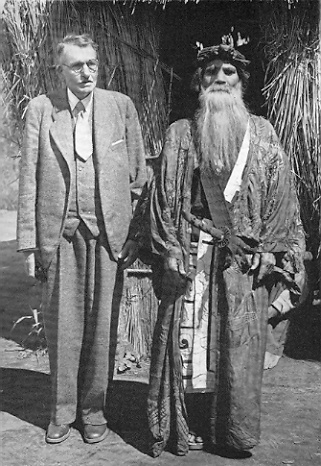
Fig. 23: Dr. Neil Munro with an unidentified Ainu ekashi, a respected elder. The title, “ekashi” is not given to everyone, it tells of a modest person who worked hard for his family and the Ainu people.
The major differences between the condition of Ainu and American Indians are political and legal. Legally recognized tribes are sovereign governments. The American government knew the land belonged to the Indians, and while this did not stop them from stealing most of it, it was the basis for treaties, many of which included reservations. More importantly, if you were believed to be the lawful owners of the land, you automatically had “legal standing”. This gave American Indians the right to seek redress in the American judicial system. Today legal standing still drives the agenda. For example, Indian tribal governments have the authority to operate gambling casinos, even when the state in which the reservation exists forbids gambling. That’s powerful! Of course, the story of the Indians is much more complex than this.
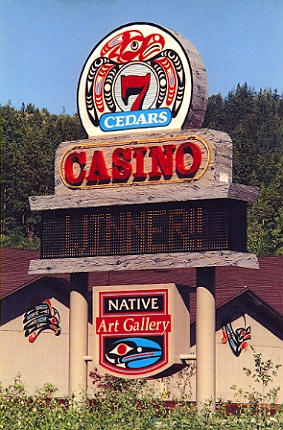
Fig. 24: An Indian casino can only make a great deal of money if the tribal reservation (the only place where a casino is allowed) is accessible to a much larger population. A tribe in a remote rural area that was extremely poor ten years ago without a casino or other ways to make money, is an extremely poor tribe today.
The problem is not all reservations are in populated or accessible areas that support gambling. Take for example, the Blackfeet Reservation in northern Montana. To simply say that the Blackfeet are in abject poverty is not to understand the situation. Extreme alcoholism, school dropouts, spousal abuse, child abuse, suicides, has translated to an almost total lack of social/educational opportunities. On all roads leading to the reservation there are many white crosses, sometimes with splashes of color from small bouquets of plastic flowers, sad memorials to commemorate the Indians who died at that exact spot. These crosses are the hallmarks of contemporary Blackfeet culture. Spending time there soon leaves you depressed. You ask yourself, is this America? How can the world’s richest nation continue to let this happen?
As bad as these conditions are, legal standing still makes a big difference. The Indians can, and do, sue the American government in court, and they occasionally win! Of course, there are those, including governments, who are devoted to breaking the treaties.
The Japanese and Russians arrogantly believed the Ainu had no rights. When they were able to beat the Ainu at war the winners got everything, while the losers lost everything, even the right to exist as a people. The Ainu have no treaties or reservations, and I know of no area where the Ainu receive treatment comparable to that of the American Indian in terms of rights. There are three areas that they do share to a certain degree: mental abuse, alcohol abuse, and suicide. As stated I believe the incidences of each of these are higher in Indian culture than in mainstream North American culture. Even here there are many programs at the tribal and state levels to help Indians, but welfare is not what is needed.
JD/RD: American Indian renewal has been mainstreamed by a growing number of American Indian scholars, writers, and artists. Are there Ainu Studies programs headed and taught by Ainu people in Japan or elsewhere?
KD: Yes, there are some courses, often with guest speakers who are Ainu. I know of one degree program, the Research Center for Ainu and Pacific Rim Cultures at Tomakomai Komazawa University. I have spoken there and was very impressed with the quality of the students, but when I asked director, Murai Yasuhiro, where the graduates for jobs, he had no answer. Interestingly, there may be more American schools that include Ainu studies as part of their programs at schools such as the University of Alaska, Central Michigan University, and Sterling College in Vermont. On the other hand, partly because of the reservation system, American Indians do have employment opportunities. More important, government and national corporations actively recruit Indians. Education has become a priority for most tribes. About twenty reservations have their own colleges, and most mainstream colleges have scholarships and special programs, including cultural support, for minority students. You can get a doctorate in American Indian studies or Indian art history at several universities such as Cornell, Harvard, University of Washington, and the University of Arizona. In addition to these areas of study, many Natives major in both the social sciences and scientific inquiry, especially in the area of environmental science. Many of these Indians remain on the reservation to work for their people. However, ‘brain drain’ is a problem. For many Indian professionals, there are very few opportunities on the reservations, so they go to where the good paying jobs are. Interestingly, a surprising number of these professionals return to the reservations when they retire. Even with the social problems, the reservations are still home.
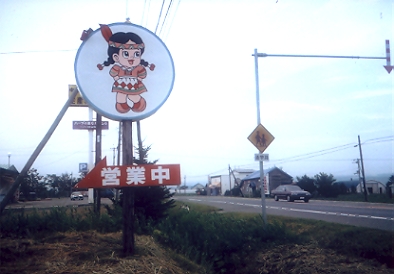
Fig. 25: If you were traveling through Indian country in the American Southwest, you would see countless commercial images such as this. Is it appropriation? Of course, but the Native art sold is made by Native artists. The problem in Japan is that you never see similar advertising using Ainu images. The Indian girl is announcing that the business is open, why not an Ainu child? I find this very disturbing.
It is not just American Indians who are advancing. I would be remiss if I did not mention the many educational opportunities the Native people of Canada have. For example, you can get doctoral degrees at many universities, perhaps even more than America. I think it is important to repeat that Canadian aboriginal peoples have also made giant strides in the area of land claims using oral traditions as evidence. While there are many problems in Indian country, the situation of North American Indians is dramatically different from that of the Ainu.
JD/RD: Land rights are another shared issue between the Ainu and indigenous peoples around the world. While the Russians and the Japanese are discussing ownership of the Kurile Islands,
there is a lesser-known debate, among some Ainu people, that the islands should be instead returned to them. Some activists think the new World Heritage site, Shiretoko, should be reserved for Ainu spiritual ceremonies, hunting and fishing traditions. Are these struggles positive or futile?
KD: Political struggles are never a constant march forward. There are ups and downs depending on variables including personalities and events. Activist work on land issues began long before the 1997 Ainu law. The struggle for civil rights, land rights, and respect will continue until we convince the government, with the help of enlightened Japanese, that it is in their best interest to return what is ours. The modern struggle is not a case of being positive or futile, it is our fate, it is our hope. If we do not have hope to act on, we will have lost.
The issues of land theft of the Kurile islands are complex because both Russians and Japanese are involved. Of course the Ainu, victims of this theft, are not party to any negotiations. The Ainu have petitioned the Japanese for possession of at least one of the islands to be held in common for Ainu people should Japan “win.” (A point of clarification – only the four southern most islands of the Kurile chain are in dispute. The rest of the islands belong to the Russians. There are no discussions to return any of these islands to the Ainu.)
Considering that the Japanese have refused to enter into good faith negotiations with the Ainu over any land issue, I am not optimistic about the outcome. Even if the Russians cede the islands to Japan, which is unlikely, we will have to fight for every square meter of land. The likelihood of getting all the islands is unrealistic. To gain even one of the islands, the Ainu have to mount a legal campaign similar to the legal fight of Canada’s Gitksan people as discussed earlier. However, this is easier said than done. To fight legal wars with the Japanese government would require a great deal of money, time and commitment. Where is it going to come from? Who is going to work full time for zero wages? However, I am encouraged by the Gitksan’s victory. With a careful examination of our oral history and recent advances in international aboriginal land claims law, and with the help of those who respect the civil rights of all peoples, I can see a possibility of victory. As I said above, we have to hope, but it takes more than hope, it will take a great deal of work.
Equally unrealistic is the thought that Japan would ever give up Shiretoko. The Japanese government, with some Ainu participation, worked very hard to have Shiretoko made a World Heritage Site. While the Japanese claim was based exclusively on the marine and terrestrial ecosystem of the area of Northeastern Hokkaido (with no reference to Ainu civilization), the people of Hokkaido, both Ainu and Japanese, are excited and proud to have the site.
Revival
JD/RD: Artists such as Peramonkoro used the arts as a way to express and strengthen themselves personally and culturally. What are your thoughts on the role of the arts in Ainu cultural healing and revival, as well as in fostering diversity within Ainu culture?
KD: The arts and spirituality, for many artists, are one and the same. For indigenous people, the arts are more than personal expressions of freedom; they help us to stay in touch with the traditional inner self. The arts are the songs of our soul.
The work of Peramonkoro, and her son Bikky, gave artistic freedom to those Ainu who wanted to go beyond traditional constraints. There is always pressure to remain traditional, but their work gave us the “creative passport” to move forward. Together, they proved that it was possible to treasure tradition while at the same time traveling to the far reaches of our Ainu culture. Change will occur. It must! I believe strongly that indigenous art reflects the cultural health of the people. Bikky, who designed what has become accepted as the Ainu flag, showed us that we must not wait for “permission” to move beyond the mental boundaries forced on us. History is filled with countless indigenous cultures that have died out because, in part, they did not evolve. My research in the arts of the Native people of North America has shown that the more robust Indian cultures have the strongest combination of diverse traditional and contemporary arts.

Fig. 26: Bikky designed the Ainu flag in 1973. While accepted as the Ainu flag, it is rarely seen. Today a new sense of contemporary Ainu pride in part reflects collective dissatisfaction with the Ainu Shinpo (Ainu new law), which keeps the Ainu locked in traditional aspects of being Ainu. Because Bikky refused to be a “kanko Ainu” (tourist Ainu), I think he was saying we should never forget our traditional roots and we must move forward. The design in the flag consists of a red arrowhead (ay) whose color signifies the aconite poison used in hunting, a way of life that was banned by the Japanese. The white contemporary ‘Bikky mon’yo’ (Bikky design) represents the harsh snows of Hokkaido, which Bikky believed made the Ainu strong. Today the flag is occasionally seen at Ainu functions.
Bikky had little patience with Ainu who made being Ainu their only occupation, expecting the Japanese government to support them. Many young artists of today may not understand the legacy that Peramonkoro and Bikky have given us, that being the gift of growth. It’s not an artistic revival that the Ainu need; we have never lost our traditional artistic roots, but we could. We need the vigor of youth to build on those roots to lead us to new heights. But we can’t do it by ourselves. Native Americans and the indigenous people of Canada had the support of non-Natives in their fight for respect for Native art and culture. That respect gradually changed the view that Native art was indeed fine art. In North America the move toward fine art was shared by governments, art lovers, entrepreneurs, and art schools. All the above groups in Japan need to encourage artists to move beyond craft.
JD/RD: Bikky spent a short time on Canada’s Northwest Coast. Was he influenced by Northwest Native art?
KD: There is no doubt Bikky was impressed with the Canadian Northwest Coast art, especially old totem poles, but it was the condition of the Native artists deeply impressed him, above all because they were respected! People wrote books about them and their art because they were respected! Most of all, Bikky was an Ainu artist working among his Native North American peers. He had finally found respect!

Fig. 27: While Bikky finally found self respect in British Columbia, he never lost respect for the Ainu belief system. Upon receiving a log, he would hold a kamuy nomi, a prayer of thanks to the god of the tree, praying for its help in finding the image he was seeking. Ainu believe the object the artist is searching for is in the wood. It is up to the artist to find it. It is difficult to see the ikupasuy (prayer-stick) but Bikky has dipped the ikupasuy in sake, and is sprinkling it on the log.
Proof of this respect was his being invited by the late Haida artist Bill Reid to work in Reid’s studio. Reid, thought by many to be Canada’s most accomplished Native artist, was very impressed with Bikky’s talent and commitment to his art. When I interviewed Reid for my book on Bikky, Reid described Bikky as one who “Looked like a bear, drank like a fish, and worked like a beaver.” Bikky did have a drinking problem but he had an interesting outlook about drinking and art. While he drank moderately during the day, the nights were his biggest problem. When asked why he controlled the drinking the day and not at night? I found his answer most interesting; “I carve during the day, sometimes with power tools. If I got drunk, I could really hurt myself. At night I paint! Nobody gets hurt painting.” Very practical!

Fig. 28: Bikky could carve very delicate works of art, but I believe he really enjoyed attacking his works in the harshest of natural elements. Here he drives his axe through the ice and snow on the log as he seeks the image.
As talented as Bikky was, he had his own problems with self-respect, but as he fought demons, he became a political activist on Ainu issues. Bikky had lived the problems that all Ainu faced. To have self-respect and to be respected is something we all want, whether we are Native or not. I believe that there are more ‘Bikkys’ among our Ainu artists, artists who believe in themselves, artists with the passion to make themselves heard, and artists who are respectful of their traditional artistic roots, but will not be held hostage by them. However, no matter what you feel, you still have to have a chance, someone to believe in you.
It is no secret that I strongly support contemporary art, but not at the expense of traditional art. My research has shown it is ‘inexpensive’ art for the tourist that supports Indian artist’s’ families. This is most often not ‘fine art,’ it’s mostly craft, but the artist who can devote some time to improve his or her art may attain fine art. It is the rare artist that doesn’t begin his or her work in the tourist market, but they do not have to stay there. It is the Ainu people, not just artists, who need to stop listening to the racist remarks that assail us everyday. I know this is not easy, but what are the alternatives?
JDRD: Who are some other Ainu artists and activists?
KD: Without doubt the biggest influences on contemporary Ainu art and/or political activism have been Peramonkoro, her husband Ichitaro, and others such as Hokuto Iboshi, Genjiro Arai, Michi Arai, Kamegoro Ogawa, Tasuke Yamamoto, Shoji Yuki and Giichi Nomura. Unfortunately they have received little credit for their contributions. Without Peramonkoro, Bikky’s art and his activism would have no doubt been much different.
Today Kawamura Noriko continues the legacy that Peramonkoro left us. The art of the Jomon and Ainu have always had an abstract quality to it, and Noriko has taken that abstraction to a higher level. While much of our traditional art was ceremonial, today she produces work to be enjoyed for what it is, fine art. For the Smithsonian exhibition, I asked Noriko to create a large textile image that would represent the main theme of the exhibition, “Kamuy,” our gods, and the spirit of the Ainu. The result was awe-inspiring.

Fig. 29: For the Ainu, god is an abstract concept without human form. I was completely taken by Noriko’s image, it is so positive. Today most Ainu combine Buddhist with many traditional Ainu beliefs.
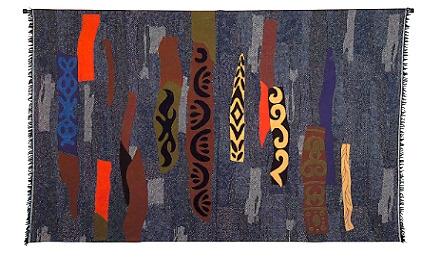
Fig. 30: This piece was inspired by our sacred prayer-sticks, the ikupasuy. Much of Noriko’s work is quite large, but she does take smaller commissions. This piece, Mokurei (Wooden Spirit) is 300 x 180 cm (10’ x 6’) an average size for her.
Fine art of another kind is the work of another incredible Ainu artist, Fujito Takeki. His realistic carvings of wildlife are not only breathtaking; they honor the spirits of our gods. He has also honored some of our Ainu elders who helped keep the fires of the Ainu alive during the last century. He immortalized them with life-sized sculptures. He gave each of them his best.
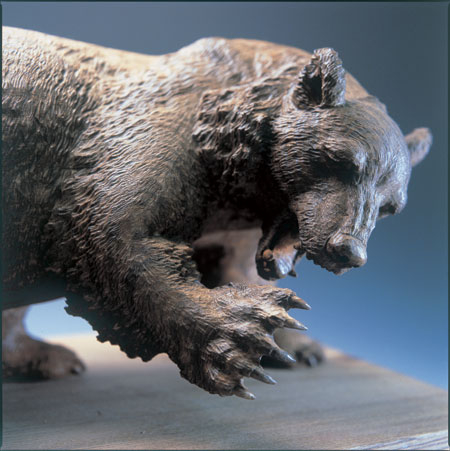
Fig. 31: The wildlife art of Fujito Takeki is truly amazing. He creates all manner of wildlife with equal intensity. An extremely modest man, he sees himself as a simple bear carver.
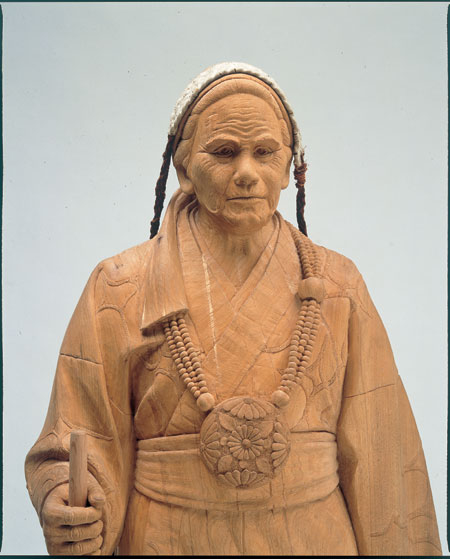
Fig. 32: Fujito has also honored the elders of the 20th century. This detail is from a life size statue of Fujito’s grandmother, Fujito Take. Words fail me to try to describe his work.
Certainly the most well known Ainu leader and writer is the late Kayano Shigeru. While not politically assertive such as those listed above, he has written more on things traditional than anyone, Ainu or Japanese. His work includes Ainu mythology, a dictionary of the Ainu language (emphasis on the Nibutani Ainu dialect), material culture and a very popular autobiography of his earlier life. In 1994 he entered the national political fray by running for the Japanese Diet, not on an Ainu platform but as a Socialist Party representative for the Nibutani area. He is often credited with being the first Ainu to be elected to the Diet. Actually he came in second in the election only to replace the winner who resigned. He did not win on his own merits.
Bikky Sunazawa and Kayano were good friends. A sign of their mutual respect for each other was Kayano’s use of the colors and symbolism in the Ainu flag that Bikky created, in his lapel pin (lapel pins are very important for Japanese politicians). Lasting only one term, Kayano’s efforts on behalf of the Ainu were basically ignored, and no pro-Ainu legislation was passed. He was deeply disappointed in the lack of achievements on behalf of the Ainu nation, a burden he carried the rest of his life. He was a good and gentle man. His legacy is great, as it should be, but it is sad that the others, the fighters, are not remembered as well.
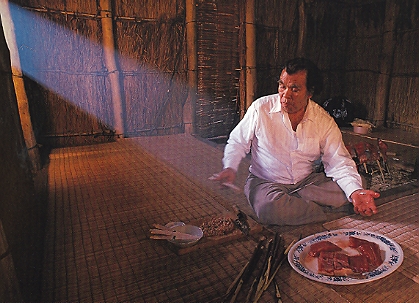
Fig. 33: Kayano was the last real link to the traditional. I believe this photo captured not only his spirit, but his connection with the gods.
As stated above, Ainu art is held captive to the belief that Ainu art is not art. Unfortunately, it is not just the Japanese who think this way. The Ainu themselves refer to their work as craft. For example, Ainu organizers entitled their excellent 2003-4 traveling exhibition “A Message From The Ainu: Craft and Spirit.” If we don’t believe that we create fine art, we will never change the opinion of others. We must get past the negativity foisted on us.
Things are slowly changing for the better. Prior to the Smithsonian exhibition (1999-2000), Ainu were rarely consulted on Ainu exhibitions of any kind. It was the Japanese who were the curators. At the Smithsonian I argued for unprecedented Ainu participation, and my co-curator, Dr. William W. Fitzhugh, supported me. My husband David, who was project manager, and I traveled six times to Japan over a three-year period. We traveled throughout Hokkaido and Honshu to consult with many hundreds of Ainu. Because of them, many of the fine points of the exhibition plan were changed. For example, I hired Nomoto Masahiro, who is now a curator at the Ainu Museum in Shiraoi, Hokkaido, [www.ainu-museum.or.jp/english/english.html ] to create the major traditional Ainu items, including a “chise” (traditional house), and the itaomachip, the traditional ocean-going canoe. I am Ainu, but I knew nothing about traditional construction of canoes. I wanted authenticity. I knew the chances of anther important exhibition of the Ainu in America may never come again. Nomoto is an Ainu traditionalist, as close as anyone could be in the twenty-first century.

Fig. 34: When developing the Ainu exhibition at the Smithsonian, a large log was needed to make the itaomachip (canoe). Nomoto Masahiro makes the first cut as part of the ceremony to the god of the tree.
Slowly the Ainu are taking their rightful place as curators of exhibitions about us. For example, Nomoto is now being consulted on Ainu exhibitions throughout Japan. When you have been ignored as long as we have, this is an exciting step forward. But why did it take Nomoto working on the Smithsonian exhibition before he could become ‘acceptable’ to the Japanese? Could he now be a curator on a non-Ainu exhibition? Certainly not any time soon.
There is another problem in Japan that is harder to solve, that being discrimination against women. Of course, this is not just a Japanese issue. The catalogue for the “Ainu: Craft and Spirit” exhibition had a section on “Outstanding Artists.” Unfortunately, only men were featured. It is not a surprise that the selection was made by men, Ainu men. While each was a legitimate choice, there were Ainu women artists who are just as qualified.
The list of current activists is much smaller. One well-known activist is Kawamura Kenichi, owner of the Kawamura Kaneto Ainu Memorial Museum in Asahikawa, opened by his father Kaneto in 1916. Kenichi is devoted to the protection of Ainu culture, both traditional and contemporary. He recently rebuilt the museum’s traditional chise that was used for ceremonial purposes. More than a major accomplishment, for Kenichi, this was a gift for all Ainu. While Kenichi could have applied for governmental Shinpo (New Law) funding, he wanted the chise to be built and paid for by Ainu people and Japanese who felt a special kinship. For example, one Japanese nurse quit her job in Sapporo to work full time on the project. I was especially proud of Kenichi, the Ainu people and those dedicated Japanese as I sat during the “chise nomi” (prayers for a new house). I thought this is positive activism at its finest. Without the leadership of Kawamura Kenichi, this would not have happened. Kenichi also lectures at local universities, gives interviews, etc. There is also an activist area that is producing good results, and that is the judicious use of lawsuits against those Japanese who misuse Japan’s copyright law, for example, using Ainu images to promote Japanese projects without obtaining permission. The Ainu are beginning to challenge the wrongs against them.
There is another type of activism that is often overlooked, and that is the work of small grassroots’ non-governmental organizations, NGO’s. One such group is “Yay Yukar no Mori” (Yukar Park), established by a group of Ainu volunteers in 1991. They set out to study, learn, and pass on traditional and contemporary skills to the next generation Ainu people as well as the Japanese public. They have explored a wide variety of Ainu related cultural activities beyond the usual. They work on environmental issues, certainly the work of the gods. This work has earned them “soft gentle rain” in their personal lives. They work on political problems that affect the Ainu. They also visited American museums with old Ainu collections to learn the work of their ancestors, and sometimes, they have found pictures of grandfathers or grandmothers. Perhaps most important, they publish an outstanding newsletter. Communication is the glue of every successful group. The head office is located in Sapporo, and the organization has been managed by an Ainu husband and wife team, Keira Mitsunori and Keira Tomoko. For any small volunteer organization to still be viable after sixteen years is what will keep the Ainu alive as a culture.
JD/RD: Because of international pressure, the Japanese government finally recognized the Ainu as Japan’s indigenous people in 1997. What are the merits and demerits of this law?
KD: Actually, the Ainu Shinpo (Ainu New Law), did not recognize the Ainu as Japan’s indigenous people. The Shinpo only recognized the Ainu’s “indigenousness,” which sounds good, but it is a long way from being an unambiguous statement. If the Ainu were declared Japan’s indigenous people, the discussion would be over, there would be no going back. But the word “indigenousness” connotes different conditions. When something is ambiguous it favors the powerful, for it is they who set the agenda based on a shifting set of conditions, and definitions of their choosing.
The closest official statement concerning who we are is found in the legal decision on the Nibutani Dam conflict, (a complex legal fight between the Hokkaido government and the Ainu of Nibutani over the proposed location of a Dam in an area of Ainu settlement). The court found in favor of the Ainu, and a different location was selected. This was a huge political win for the Ainu, but more important, the judge stated that we were Japan’s indigenous people with certain rights. The Japanese government did not appeal the decision, leaving many people to conclude that the “indigenous” fight is over.
I don’t share their optimism; we have often thought that we had won respect from the government, only to be disappointed. The Ainu Shinpo was negotiated over many years. During that time we thought we had come to agreement on many issues only to learn that we not only didn’t have an agreement, we had lost ground. The following is a short history of the period, one which I believe is equivalent to the American Indian’s Trail of Tears.
In 1984 the Ainu Association of Hokkaido (Utari Kyokai), the largest political group in Hokkaido (partly financed and overseen by the Hokkaido government), and the Ainu Affairs
Council, submitted a draft of a new law to replace the Hokkaido Former Aborigines Protection Act of 1899. The draft contained five points: (1) a declaration of basic human rights to eliminate discrimination; (2) reinforcement of the protection of human rights; (3) establishment of a fund to promote Ainu self-reliance; (4) establishment of consultative bodies on Ainu policies.; and (5) promotion of Ainu culture. The council also defined and adopted the concept of senjuken, “indigenous rights” for the Ainu and their land, resources and culture as well as political self-determination.
Over the next thirteen years, four out of the five points were deemed “potentially difficult” by the Japanese government, and they were dropped. In the end, the law only addressed traditional culture preservation and promotion, which certainly was not our first priority.
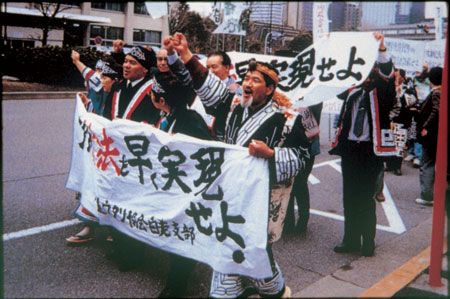
Fig. 35: Many Ainu lobbied and demonstrated for the enactment of a new Ainu law, Ainu Shinpo. This photo was taken in Tokyo in 1992. Most Ainu had no idea that the law would be so eviscerated by the time it was passed.
The law is controversial among the Ainu. Some Ainu see it as a moneymaking scheme because there was a large amount of money tied to it; while others see it as a plot to “buy off” the Ainu as part of Japanese assimilation policy. The law gives Ainu artist the opportunity to apply for funding to support Ainu art projects, and anyone can apply for an Ainu cultural related project. Interestingly the Japanese government has routinely given grants to artists of any nationality for years. The only grant given to an Ainu artist was to Bikky Sunazawa. In 1983 the Hokkaido prefectural government gave him a grant to travel to British Columbia for three months. This trip had a profound impact on him.
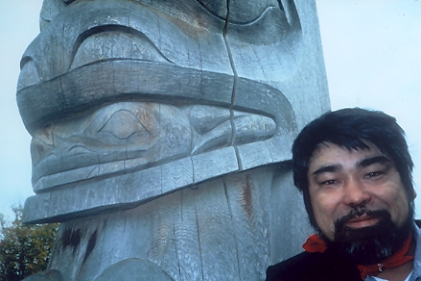
Fig. 36: Bikky was enthralled by the totem poles of the Haida and Gitksan, but he took particular pleasure in the totem poles with frogs. The name, ‘Bikky’ in Ainu means frog.
The Shinpo grants for Ainu artists have been a short-term boon, for example, there was immediate interest in re-creating the itaomachip canoe (a traditional ocean-going canoe used for maritime trade). While this is no doubt a creditable project, we suddenly began to see many itaomachip canoes being made. The question is: do we need so many canoes? I believe this gets back to Bikky’s criticism of some Ainu living off of “being Ainu.” Other positive projects include exhibition development for contemporary artists such as Noriko Kawamura.
Most distressingly there have also been some unfortunate incidents where money was awarded under fraudulent conditions, not on the part of the joint Ainu/Japanese committee that oversees the distribution of funds, but by a very few dishonest Ainu. The Japanese press reported these incidents, as they should, leaving the Ainu people as a whole to suffer because of the greed of a few. Any transgression makes it that much harder to gain the trust and respect of the Japanese people. The majority of Ainu have no intention of being “Kanko Ainu,” tourist Ainu, and after a rough start the Shinpo is no longer funding frivolous projects. There are now time-consuming ‘background’ checks. But after a few years, some obvious projects have been funded. A big problem, however, is that now the applicant must find matching funds before getting a grant. That has made it impossible for some deserving Ainu to secure support.
The loss of major issues from the original Ainu agenda have certainly made us less than equal in the eyes of the Japanese, something we refuse to accept. We do not want revenge, but we do want parity! My biggest criticism of the Shinpo is the total lack of support for higher education. There are no educational grants, and no incentives to move Ainu people out of
poverty. The Indians of North America have proved that with education you can fight injustice. I have no doubt that an educated Ainu people would be a worry to those in government who would like the Ainu to stay right where we are. Very few Ainu want a “handout,” but help is needed to overcome the legacies of the destruction of Ainu culture and continued discrimination.
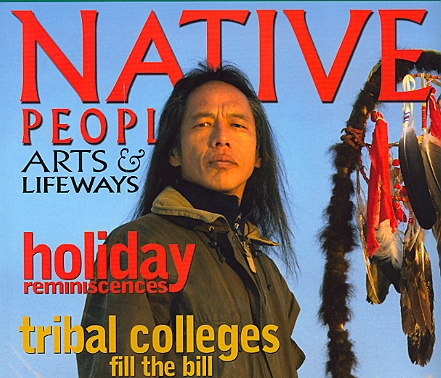
Fig. 37: Native Americans have many opportunities for a college education with more than thirty-seven tribal reservations having at least a junior college. The article on tribal colleges is from Native Peoples: Arts and Lifeways, one of three magazines dedicated to Native Americans.
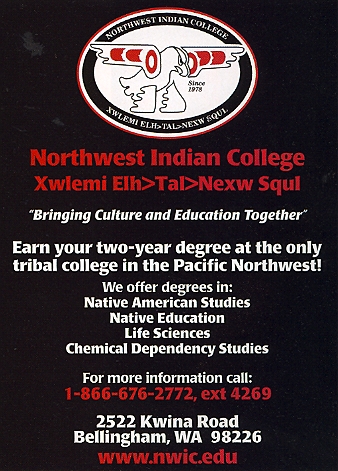
Fig. 37A : Native Americans also ran advertisements such as above, and from other institutions including Yale University, Evergreen State College where I received my bachelor degree, and three other universities. There are no magazines dedicated to the Ainu.
My question to the government is this: what was your rationale for funding Ainu language instruction and not a college education? There has never been an educational assistance program anywhere in the world that wasn’t an asset to the entire community at large. Unfortunately, there is no educational program tied to the Shinpo that will elevate the professional skills needed to enter the job market, a market beyond the tourist trade. Some Ainu do have a genuine interest in the Ainu language, and they should have the opportunity to learn, but other than the pursuit of something that has the status of a hobby, can it get you a job? Clearly the answer is no! We absolutely need to improve our ability to compete in the Japanese market place. To add to the insult, there are far more Japanese involved in the instruction of Ainu language than Ainu.
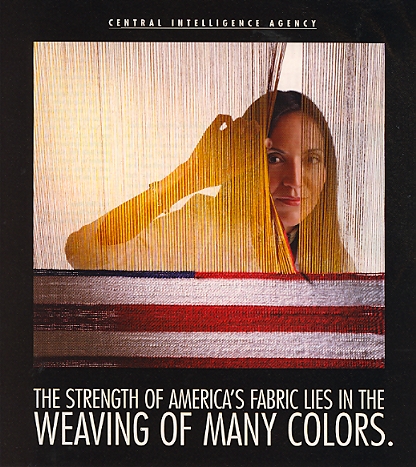
Fig. 38: There are many examples of employers who actively recruit Native Americans. In the above issue of Native Peoples, the Central Intelligence Agency (CIA) placed a full page recruitment advertisement for employment of Indians; so did IBM, the Federal Bureau of Investigation, the U.S. Army Corps of Engineers, and the VA Palo Alto Health Care System. In Japan, Ainu face open discrimination in trying to find meaningful employment.
We are Ainu, but we are Japanese as well. The Indians of America identify with their Native culture and their American culture. It is not a case of ‘either/or.’ The Ainu and Japanese can, should, and must be partners. The Japanese government, through the Ainu Shinpo, made sure that we would stay an indigenous curiosity. My research on indigenous art and culture of North America has helped me to see how little respect the Japanese government has for equality.

Fig. 39: While there are still many problems in Native America, the term, “Native American” really does refer to who they are. This beadwork from the early 1890s needs no explanation.
JD/RD: UNESCO linguistics experts consider a language endangered when it is no longer spoken by 30% of a community’s children. We read in a recent newspaper article that, “the language of Ainu in northern Japan, down to eight elderly speakers in 1980, has reawakened, with strong official support.” What needs to be done to ensure its revival?
KD: With the passing of Ainu writer, researcher, curator and Diet member Kayano Shigeru, I know of no Ainu who is a fluent speaker. Even he stated that his Ainu language was not viable. The language he knew as a youth did not evolve, it couldn’t. There weren’t many people to talk to. Many of the Ainu who knew the language wouldn’t speak it for fear of even more discrimination. If a language is not used in daily life, it does not change as the culture changes. With the passage of the Shinpo, there are many programs to ‘learn’ the Ainu language, including university courses, programs maintained by regional Ainu groups, and radio language programs. Honestly, I do not believe the Ainu language of today will go beyond hobby status. We have not only lost vocabulary; more importantly, we have lost nuance. Certainly it’s a noble challenge, but we have to ask ourselves critical questions. For example, Ainu language is one of the cornerstones of the Ainu Shinpo, but what is the goal? Do they expect the language to be an integral part of Ainu culture, after having forbidden us to speak Ainu for a century? Even the language of our ceremonies has been, for the most part, lost. We have to face the fact that the Japanese language is the language of Japan, and we were forced to be part of Japan. The Ainu language will never again be the ‘spoken’ language of the Ainu people, and to now throw money at us for Ainu language study is hypocritical! I point to the language problems in Canada. There has been a long-standing law that Canada must be a bi-lingual country with English and French being the official languages. I lived in British Columbia, Canada for almost five years. In my experience, the goal of bi-lingualism simply isn’t working. Many products do have French and English names on packaging, from soup cans to laxatives to art books such as The Inuit Print/ L’estampe Inuit. But more important, even in the province of Quebec, which is mostly French speaking, the vast majority of Canadians are not bi-lingual. I know there will be Ainu that will criticize me, but I do not believe the language provision is ever going to help the Ainu. We have many more important issues.
JD/RD: You’ve mentioned that you pin your hopes on Japanese young people to change Japan’s monoculture myth and help Ainu-Wajin reconciliation.
KD: For any culture to last, it must evolve, and the Ainu have evolved. Certainly not fast enough, but there are pockets of growing Ainu pride. We have adapted, and we are quietly challenging the status quo in Japan. We are making ourselves heard in some areas, but we have such a long way to go. I believe the key to progress is our young people, and involvement of our elders. We need our elders to teach us, but we lose elders everyday. We must move more quickly to record their wisdom.
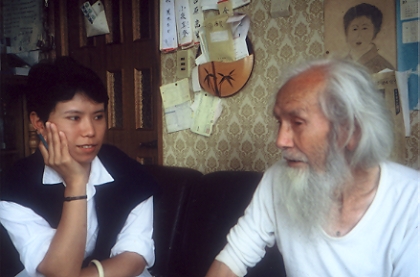
Fig. 40: As we lose our elders, we lose who we are. In the past five years we have lost Kayano Shigeru, widely known for his knowledge of Ainu material culture, and the venerable Kuzuno Tatsujiro ekashi (above) who was the authority on the subject of ceremony. I had the honor to know both men.
We must work to get the support of both Ainu and wajin youth. If we don’t, we will certainly suffer a cultural disconnect that we may not be able to overcome. If we don’t involve wajin youth and get their support, no matter what the Ainu do, it will mean little. I know that some Japanese children are still attacking Ainu children by throwing stones at them. This is madness! Tomorrow’s Japanese lawmakers are today’s youth. Trying to change the mindset of the current lawmakers is extremely challenging, for better or worse, much of the future of Ainu culture is linked to Japanese youth.
JD/RD: The Late Kayano Shigeru connected the Ainu with the pan-Indigenous movement. A Canadian Indigenous women’s group published your story about Peramonkoro. The Ainu revival is local and yet connected to a larger global process. What are your thoughts on this?
KD: With the exception of one article, all my publishing has been in America or Canada, and most of my scholarly papers have been given in America, Canada, Europe, and Russia. I have lectured in Japan, but when I have tried to publish in Japanese, I am told I am too aggressive.
For example, I was interviewed by a major Hokkaido newspaper to promote my book on Bikky. I gave the reporter a copy of the book. A couple of days later he called to say they cancelled the article because it was too political.
Clearly my efforts are aimed at the pan-indigenous movement. The Ainu have tried to obtain fair treatment for more than a century to no avail. A feeling of self-worth is most difficult to maintain without fairness, and positive movement did not really begin until Nomura Giichi,
the former Executive Director of Utari Kyokai, spoke to the United Nations General Assembly in December 1992 during the Decade of Indigenous Peoples. This is another example of external pressure being the best route to any positive movement in Japan. He worked very hard for the Ainu people with little reward. In the end he was politically forced out by regional Ainu power brokers. Sadly, most young Ainu have no idea who he is. I believe I can do more for the Ainu from outside the country. For one thing, as an Ainu woman scholar, I definitely get more respect anywhere in the world than I get in Japan.

Fig. 41: I mentioned the merits of wearing traditional attire to official functions. I differ with those who call them “costumes,” which I believe is disrespectful. Nomura Giichi, by wearing traditional clothes at the United Nations, brought positive attention to the Ainu.
JD/RD: You are half Japanese and half Ainu. Yet you identify more with your Ainu heritage. Why?
KD: I identify with being Ainu because being discriminated against from an early age makes you uncomfortable with those who discriminate against you. I had a hard time being an Ainu as a young woman, but, as I grew older, I began to realize that being Ainu had a past to be proud of. Many people have found it interesting that part of that growing feeling of pride came from my study of American Indian art and culture. For a long time it was hard not to be angry with the Japanese government for ignoring and marginalizing us, when they should be proud of who we are. Now my anger is more directed. For example, I believe the Ainu Shinpo is a lost opportunity to help lift all Ainu to a more positive place.
JD/RD: You and your husband, David, a Mohawk-Huron-French-Canadian, work as a team. Were you drawn to each other in part because of your shared indigenous backgrounds?
KD:No, we didn’t really talk about being indigenous; My English at the time was ‘interesting,’ and David’s Japanese was even more so. The first time we talked about an Indian and Ainu connection was when he asked me to go to the Tohoku University library to help him find books in English about the iyomante, the Ainu bear spirit-sending ceremony. I knew he was different: he always had a very spiritual relationship to the natural world. But more importantly, I would soon learn just how passionate he was about the rights of all peoples who had lost their ability to gain respect from the ruling elite. We both have a very hard time with discrimination.
JD/RD: You spent last year in Hokkaido after being away for several years. What was that like?
KD: When I returned to Japan, I found that I was a different person than when I lived here before. I love Hokkaido and my Ainu and Japanese friends, but education has become such a powerful focus in my life, it pains me to see both Ainu and Japanese kids learning prejudice, instead of using the gift of education, a basic right for everyone, for positive change. That is very frustrating! While I had come back to Japan to see my family, for research and to live, I now see Japan through a different lens. I have changed, Japan has changed, but the attitudes toward Ainu have changed little. They have not been able to take advantage of Japan’s growth. I find it interesting that my husband misses Japan more than I do. I suspect if the sexual roles were reversed and he were the woman, an Ainu woman, he would feel differently.
JD/RD: What does it mean for you to be “Ainu?”
KD: This is a hard question! For me, being Ainu means being a mosaic of so many things—pride, rage, disappointment, courage, hope, and pain, to name just a few. When I reflect on being Ainu, I always think of the many elders who had to endure so much more than we contemporary Ainu. I feel a sense of connection with them, but I will never be their equal. I believe they, and my belief in kamuy, our gods, guide me. But I am the one who has to do the work. On the other hand, most of all, I have always felt like an outsider. Maybe that’s why I became an indigenous art historian. It gives me a sense of belonging.
JD/RD: Finally, you have worked on Ainu issues for more than twenty years. What are the most valuable ‘tools’ to learn about the Ainu?
KD: There are many ways to learn about the Ainu. Having said that, all of them, from my point of view, have both positive and negative elements. The following are brief suggestions, with the pros and cons of some of the best known, most accessible, and least expensive (relatively speaking) resources available. If you are in Japan, the most obvious place to start any research is the museums to get acquainted with the traditional material culture. The largest museum with an Ainu section is the National Museum of Ethnology, Osaka (Minpaku).The permanent exhibition, while dated, has an excellent collection of traditional objects and some interesting dioramas.Unfortunately, as of my last visit, there was absolutely nothing contemporary on display even though the museum probably has, in storage, the largest collection of contemporary Ainu fine art in the world.
Of course that’s not the only problem. The permanent exhibition has been the subject of criticism, especially by Sandra Niessen, a Canadian scholar, (see, the October 1994 issue of Museum Anthropology). This was answered in the September 1996 article in the same journal by two professors from the Museum, Ohtsuka Kazuyuki and Shimizu Akitoshi, who defended the Minpaku exhibition. Many of Niessen’s comments would apply to almost all Ainu exhibitions in Japan. I recommend all who are interested to read these examples of the combative agenda of a major Japanese museum on the subject of the Ainu. I believe you will find it very interesting, especially since Niessen’s criticism has changed nothing at the museum.
In addition to the discussion on Minpaku, you will find Niessen’s criticism of the Canadian exhibition, The Spirit Sings: Artistic Traditions of Canada’s First Peoples as part of her response to Ohtsuka and Shimizu. The subject of exhibiting Native cultures in North America has been undergoing intense discussion over the last two decades. If you read the Minpaku material, I strongly advise you read the North American debates on exhibitions of American Indian material culture listed in the bibliography.
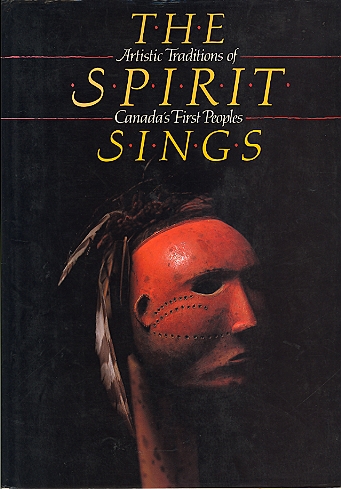
Fig. 42: Catalogue for the controversial but very popular exhibition on Canada’s First People. The controversy means that people cared about the content. No one, not Ainu, not Japanese, have ever raised concern about the content of an Ainu exhibition. Is it the case that the exhibition is perfect, or do the Ainu know that to raise an objection would be a waste of time . . . or worse?

Fig. 43: There has been ongoing debate in North America about how to display indigenous cultures. This book is published by the National Museum of the American Indian. Serious discussion is needed to help change the attitudes of those who have ethnocentric views. Japan desperately needs discussion of how to display Ainu culture. We are not objects, but that is how we are displayed.
Another valuable museum to visit is the Osaka Human Rights Museum (Osaka Jinken Hakubutsu-kan or Liberty Osaka). This museum was founded in 1985 to highlight the civil rights issues of the minorities of Japan including the Ainu. It is a small museum, but it is well worth the visit.
The next museum I suggest is the Historical Museum of Hokkaido (Kaitaku Kinenkan) in Sapporo. The Ainu exhibition is smaller than that at Minpaku, but the presentation of the Ainu is much more responsible. Unique among museums in Japan, it shows the Ainu in relationship to what was happening in Japan. Unfortunately, however, there is little discussion of how the Japanese came to power in Hokkaido. While no contemporary Ainu art is on permanent display, there are temporary contemporary exhibits. The last section of the permanent exhibition has a video presentation on contemporary Ainu people in Hokkaido. However, many Ainu don’t like the museum because it emphasizes the Japanese development of Hokkaido with no mention that the Ainu were the rightful owners of the land, nor is there anything on the Japanese who, as interlopers, set out to destroy the Ainu culture and to despoil Hokkaido’s nature.
Another very important museum is the Ainu Museum in Shiraoi, Hokkaido, the only major Ainu museum that displays a significant Ainu community.
The format is a kotan, a traditional Ainu village.Situated on Lake Poroto, the museum is often called “Porotokotan” (Poroto village). It was established in 1976 by the Shiraoi Foundation for the preservation of Ainu culture.It is the largest construction of a traditional Ainu village in Japan.

Fig. 44: The Ainu Museum is clearly best on the subject of traditional Ainu culture, but it does little or nothing to discuss contemporary gains, or lack of gains.
There are working exhibits such as dancing, singing, the making of many types of weaving, and the making of ceremonial items such as inaw, the sacred shaved sticks. The Ainu believe that the many different inaw are symbolic birds that carry the prayers of the Ainu to the gods.

Fig. 45: The many different types of inaw, extremely important spiritual icons of the Ainu, are not well understood by the vast majority of Ainu including myself. The Ainu Museum and others have the responsibility to go beyond showing objects. The museums, the keepers of knowledge, need to instruct us before they too forget.]
To handle the number of tourists visiting the kotan, there are many oversized buildings of traditional construction, which also have working exhibits. There is also a modern museum. Many kotan visitors are tourists on vacation packages. On a good day there will be up to a hundred tour buses with Chinese, Koreans, Thai, and of course, Japanese, most of them are retirees. While it can be a bit crowded, I recommend going there in the summer as there are more working exhibitions. Hokkaido is notorious for harsh winters, dramatically reducing the number of tourists.
The last tourist area of note is the kotan in Akan, a Japanese tourist center.While called a kotan, it is not a traditional Ainu kotan.Simply put, it is essentially an Ainu ‘strip mall.’It comprises a number of very similar tourist shops offering an infinite amounts of tourist kitsch with carved Ainu style designs.If you are looking for something Ainu, I will simply say, buyer beware.The overwhelming majority of objects sold there are not of Ainu manufacture; they are of Japanese, Chinese, or Southeast Asian manufacture.As stated, the designs are Ainu based.They are all deviations of Bikky Sunazawa’s art; Ainu designs taught to him by his mother, itself a deviation from gender specific cultural norms.Today the designs are known as “Bikky mon’yo” or Bikky designs.
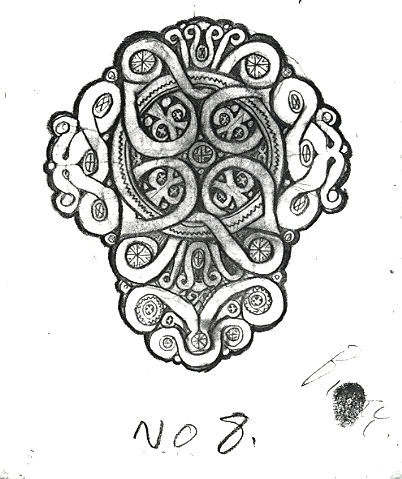
Fig. 46: My research has shown that Bikky created thousands of designs. The man never stopped creating. Simply put, he was the consummate artist.
The kotan has two distinct agendas; the most apparent are the commercial aspects. While the majority of works are cheap carvings, fine art can also be purchased such as the wildlife art of Takeki Fujito. There is also one shop that specializes in clothes with Ainu designs for Japanese and foreign visitors such as an Ainu style happi, the short Japanese lightweight ‘jacket.’ Some of the designs are very beautiful. There is another tourist shop, “Poronno” that advertises Ainu food. Basically, it is a very small ‘coffee shop’ at the back of the tourist kitsch section. The closest they come to Ainu food is a kind of ‘potato mochi’’ (imo-shito). While the owners are fantastic people, the shop is not a restaurant in any sense of the word.
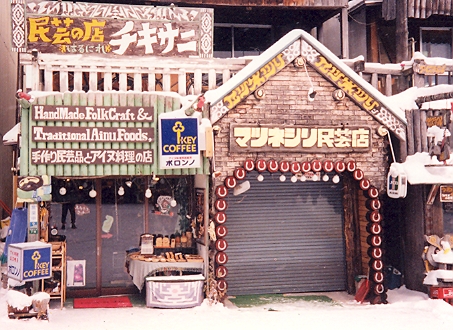
Fig. 47: You can get a good cup of coffee or tea at this shop. Most of the shop workers in the kotan (Ainu community) stop in for coffee during the day. Almost everyone is willing to talk, making it a good place to learn.
The other agenda is the preservation of Ainu culture. During the tourist season, May through September, the order of the day is business! The rest of the year is a snowy wonderland, with accumulations of up to six to eight feet of snow at any one time, more than enough to discourage the hardiest tourist. It is during this time that the Ainu work to introduce Ainu culture such as traditional dance, which is performed for the tourists. The introduction of culture is difficult because the Ainu living in Akan are not from Akan, they came to the area for business purposes. Akan was never a traditional Ainu territory, so there are no local traditions. This is important because even though Hokkaido is not a large island, each Ainu area had its own traditions, ceremonies, and local dialect. Basically, the traditions of the Akan Ainu are developing a composite of the major Hokkaido Ainu areas. I suspect the oldest influence is from the Chikabumi kotan, which was near (now a part of) Asahikawa. My research on the Sunazawa family shows that Peramonkoro was one of the first to set up ‘shop’ after World War II, and the family business is still there. There are other Chikabumi Ainu who are important resident merchants. I must add that all Ainu businesses are not in the ‘kotan,’ several businesses are throughout Akan village. While the commercial part of the kotan is well established, it is too early in its evolution of the ways of the Ainu to know whether this ‘new’ settlement will be known primarily as a community of Ainu, or merchants.
For those seeking more serious research, I suggest going to the Hokkaido Ainu Culture Research Center (Hokkaidoritsu Ainu Minzoku Bunka Kenkyu Senta) in Sapporo.Their major study areas include the different language dialects of Hokkaido Ainu groups.They also research traditional foods, modern Ainu history with emphasis on education issues, ethnology, and performing arts and music. They also have a good collection of books for on-site research.Most of those working there are Ainu.Unfortunately, there is no official website for them.
Another resource in Sapporo is the Ainu Association of Hokkaido (Hokkaido Utari Kyokai). Its main activity is to maintain the link between the Hokkaido Prefectural government, which provides most of the funding, and management of the membership of Utari Kyokai, which number approximately 25,000, a figure that includes Japanese spouses who married an Ainu but does not include those Ainu who do not wish to belong to the Association, or Ainu living elsewhere in Japan. Utari Kyokai’s major role is to research ‘traditional’ issues, and issues of a political and social nature. For example, they were responsible along with the prefectural government for the development of the Ainu Shinpo. They have the obligation to encourage exchange with other indigenous groups in the world, a charge they are fairly successful at. They are also charged with developing employment opportunities. Unfortunately, this is the least successful of their mandates.
While the Ainu Association of Hokkaido is the ‘best’ organized Ainu group in Japan, they are not without controversy. There can be bitter political in-fighting between different Ainu areas, and as the group responsible for the creation of the Ainu Shinpo, they have been the target of harsh criticism from opponents of the Shinpo. Clearly there is a lack of discipline within both the rank and file members. I believe the ongoing fight for power has hurt the Ainu people, perhaps permanently. Thus, for example, positive changes in the Shinpo are beyond the vision of the leadership of the Ainu Association of Hokkaido. Until the organization becomes independent of the government, it will never attain a high level of trust or support from the Ainu people.
The Association for the Transmission and Maintenance of Ainu Intangible Culture (Ainu Mukei Bunka Densho Hozonkai) shares the office with the Ainu Association. Their main activity is the preservation, transfer and development of traditional Ainu culture. Toward this end they have produced a great number of quality educational Ainu videotapes, which are available for purchase. This has been a very successful endeavor. While some of the videotapes are of actual traditional ceremonies, the majority are recreated traditional subjects.
Lastly, the Foundation for Research and Promotion of Ainu Culture (Ainu Bunka Shinko, Kenkyu Suishin Kiko) was established in 1997 by the Hokkaido Government, the Hokkaido Development Agency and the Ministry of Education. The office is also in Sapporo, and is the official administrative body of the Ainu Shinpo.They are charged with adminisering four main areas, the Promotion of Comprehensive and Practical Research of the Ainu, Ainu Language, Ainu Culture, and the Dissemination of Knowledge of Ainu Traditions. In the 2004 summary report of the Foundation, Chairman Tanimoto Kazuyuki states in his annual message, “With so many Ainu continuing to suffer from discrimination and poverty, it is currently difficult to say that Ainu culture has been properly preserved or orally handed down, making the preservation and promotion of the culture an urgent necessity.”
While this is true, it is most difficult to see how preservation and promotion of Ainu culture will move anyone out of poverty. Bikky Sunazawa had little patience with Ainu making their living being Ainu. I do not quite agree with Bikky, there are Ainu making a career out of being a ‘kanko Ainu’ (tourist Ainu), and it is an honorable way of making a living, but how many ‘kanko Ainu’ can there be? Ainu tourism is not a large industry. When you digest the goals of the Shinpo, and Tanimoto’s statement which implies that the preservation and promotion of Ainu culture will lift us out of poverty, there can be but one job opportunity and that is being a kanko Ainu, or in a closely aligned kanko industry. I believe we must offer more to our young people.
There are also a large number of books and/or articles in many areas for research. Unfortunately, the disparity in the quality of books is dramatic. The problem is that the buyer is apt to get something that propagates the misinformation that is rampant throughout the discipline. I will give just one example. In 1565 a Jesuit priest, Father Lois Frois, witnessed a ceremony in which a sacred prayer-stick, an ikupasuy, was used. Many ceremonies have sake in a special cup called a tuki. As prayers are said the ikupasuy is dipped in the sake and sprinkled on inaw, sacred shaved objects. When the ikupasuy is not being used, it is placed on the tuki. Ainu men traditionally have large beards and mustaches. When sake is drunk, the ikupasuy stays on the tuki. Father Frois, thinking the prayer-stick was lifting the mustache to drink, coined a new term, “mustache lifter.” Today, almost 500 years later, “mustache lifter” is still the term of choice in the literature. The ikupasuy is the most important personal object. We believe that humans cannot express their prayers properly, and the ikupasuy transforms human prayer to an acceptable form for the gods. I have devoted myself to overturning the misnomer but misinformation is most difficult to change.
In the bibliography I list what I regard as good books at a reasonable price and availability. Ainu books can be very expensive, a few are over $2,500 (U.S.) and extremely difficult to find. The Japanese publishing industry, by design, often has a print run of only 500 copies for a scholarly book, and most of these go to universities and government offices. If you can’t find a book you are looking for, there is only one bookstore that specializes in Ainu books and I strongly recommend it. They will try their best to find your book. While very helpful, they do not speak English, but of course, if you have a title in romaji, it will be no problem. They also don’t accept credit cards but for those who are out-of-country, international money orders and bank drafts are accepted. Unfortunately, they don’t have a website. Contact information is:
Sapporo-do Shoten
(owner: Makoto Ishihara)
Address: 1, Nishi 4-chome, Kita 10-jo, Sapporo, Hokkaido 001-0010
Tel: (+81) 11-746-2940/ Fax: (+81) 11-746-2942
The last source of research ‘material’ I will comment on is the human type.The Ainu have been a subject of European and North American research for more than 500 years.There were missionaries, linguists, early and later anthropologists, ethnologists, ethnomusicologists, ethnobotanists, historians, political scientists, and so on.The Ainu became the subject of a cultural Petri dish, and they did not like it!Some Ainu saw that they could make the researchers pawns in a game, deliberately saying whatever the researchers wanted to hear, or deliberately lying to them.Of course, like any people, many Ainu do not know their history well.It must also be noted that individual Ainu (and Japanese), are like individuals in any group of people, they have their own agendas, and that certainly includes me.I urge anyone who is serious about learning the social, political and spiritual beliefs of both the traditional and contemporary Ainu, to seek out as many educational sources as possible before making up your mind as to who we are.
To those who are trying to do something ‘good’ for the Ainu, please be sure you know what you’re talking about.Recently it was pointed out to me that an anthropologist was trying to help us regain our land.Not a single fact that he presented about the Ainu was accurate, however.I know of many people who tour Hokkaido for a month or two visiting Ainu tourist areas, interviewing a few Ainu, and then publish a “scholarly” article or even a book.Of course, there are some excellent outsider writers whom I respect very much, and they are listed in the bibliography.But where are the good Ainu authors?I end this Interview with a plea, don’t believe everything you read, . . . or hear . . . or see.Look below the surface, and don’t try to make us fit your expectations.
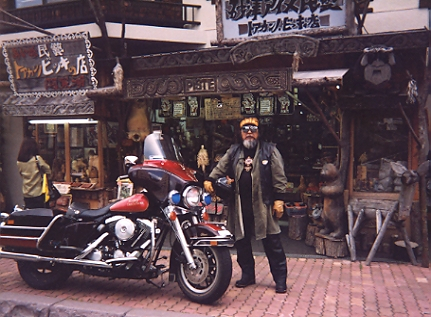
Fig. 48: Sunazawa Kazuo, the brother of Bikky, owns the tourist shop in the background. As long as the Ainu have people like Kazuo and artist Takeki Fujito, another Harley-Davidson bike rider, the Ainu will stay current, at least in Akan.
For all indigenous people, everyday is both an ending and a beginning. Thank you for your interest in the Ainu people.
Bibliography (English)
Bachelor, John
The Ainu and Their Folklore. London Religious Tract Society.
Ainu Life and Lore: Echoes of a Departing Race. Tokyo: Kyobunkan. Reprint,
New York: Johnson Reprint Corp., 1971.
Bird, Isabella
1881 Unbeaten Tracks in Japan. New York: G. P. Putnam’s Sons. Reprint, Rutland, Vt., and Tokyo: Charles E. Tuttle Co., Inc., 1973.
Chatter, James C.
2001 Ancient Encounters: Kennewick Man and the First Americans. New York: Simon & Schuster.
Chikappu, Mieko
1998 “Salmon Coming Home in Search of Sacred Bliss.” In First Fish, First People: Salmon Tales of the North Pacific Rim, ed. Judith Roche and Meg McHutchison, 58-63. One Reel; Seattle and London: University of Washington Press.
Dubreuil, Chisato O.
1999 “Ainu Art: The Beginnings of Tradition.” In Ainu: Spirit of a Northern People, ed. Fitzhugh and Dubreuil, 287-300. Published by the Arctic Studies Center, National Museum of Natural History, Smithsonian Institution in association with University of Washington Press.
— “Ainu Journey: From Tourist Art to Fine Arts.” In Ainu: Spirit of a Northern People, ed. Fitzhugh and Dubreuil, 335-353. Published by the Arctic Studies Center, National Museum of Natural History, Smithsonian Institution in association with University of Washington Press.
2002 ‟Ainu Art on the Backs of Gods: Two Exquisite Examples in the Detroit Institute of Arts Collection” for the Bulletin of the Detroit Institute of Arts, Volume 76, No. ½.
2003 ‟The Enduring Art of the Ainu” in Tribal magazine (formally the World of Tribal ARTS), Number 30, Spring.
2004 From the Playground of the Gods: the Life and Art of Bikky Sunazawa. Published by the Arctic Studies Center, National Museum of Natural History, Smithsonian Institution. Distributed by University of Hawaii Press.
—- ‟Ainu-e: Instructional Resources for the Study of Japan’s Other People,” an article for Education About Asia, a publication of the Association for Asian Studies, Volume 9, Number 1, Spring issue.
2005 ‟Her Name is Peramonkoro!” A monograph in Sky Woman:Indigenous Women Who Have Shaped, Moved or Inspired Us. Published by Native Women in the Arts/ Theytus Books, Ltd
2006 ‟Ainu Art and Culture, A Call for Respect, an interview with Chisato O. Dubreuil,” in Kyoto Journal, issue 63, Spring.
Fitzhugh, William W. and Chisato O. Dubreuil (eds.)
1999 Ainu: Spirit of a Northern People. Published by the Arctic Studies Center, National Museum of Natural History, Smithsonian Institution in association with University of Washington Press.
Hilger. M. Inez
1971 Together with the Ainu: A Vanishing People. Norman: University of Oklahoma Press.
Hitchcock, Romyn
“The Ancient Pit-dwellers of Yezo.” In Unites States National Museum Annual
Report for 1889-1890. 417-502. Washington, D.C.: U.S. Government Printing Office.
Howell, David L.
1995 Capitalism from Within: Economy, Society, and the State in a Japanese Fishery. Berkeley, Los Angeles and London: University of California Press.
Hudson, Mark J.
Ruins of Identity: Ethnogenesis in the Japanese Islands. Honolulu: University of
Hawai’i Press.
Jessup, Llynda and Shannon Bagg (ed.)
2002 On Aboriginal Representation in the Gallery. Mercury Series, Canadian Ethnology Service, Paper 135. Hull, Quebec: Canadian Museum of Civilization.
Jones, Nick
2005 “Northern Exposure” in Tokyo American Club: iNTOUCH (Februray 2005): 26-31.
Karp, Ivan and Steven D. Lavine (ed.)
1991 Exhibiting Cultures: The Poetics and Politics of Museum Display. Washington and London: Smithsonian Institution Press.
Kayano, Shigeru
1985 The Romance of the Bear God: Ainu Folktales. Tokyo: The Taishukan Publishing Company.
1994 Our Land was a Forest: an Ainu Memoir. Trans. Kyoko Selden and Lili Selden. Boulder, Colo.: Westview Press.
1998 “Traditional Ainu Life: Living Off the Interest.” In First Fish, First People: Salmon Tales of the North Pacific Rim, ed. Judith Roche and Meg McHutchison, 22-39. One Reel; Seattle and London: University of Washington Press.
Kayano, Shiro
1998 “Who Owns the Salmon?” In First Fish, First People: Salmon Tales of the North Pacific Rim, ed. Judith Roche and Meg McHutchison, 40-45. One Reel; Seattle and London: University of Washington Press.
Kreiner, Josef (ed.)
European Studies on Ainu Language and Culture. Munich: ludicuium-Verlag.
Mejewicz. Alfred F (ed.)
The Collected Works of Bronishaw Pilsudki, Vol 1, The Aborigines of Sakhalin.
Berlin and New York: Mouton de Gruyter Publisher.
— The Collected Works of Bronislaw Pilsudki, Vol 2, Materials for the Study of the Ainu Language and Folklore. Berlin and New York: Mouton de Gruyter Publisher.
Miyajima, Toshimitsu
1998 Land of Elms: the History, Culture, and Present Day Situation of the Ainu People. Trans. Robert Witmer. Ontario: United Church Publishing House.
Munro, Neil Gordon
Ainu Creed and Cult. Reprint, London: Greenwood Press, 1979; London and
New York: K. Paul International, distributed by Columbia University Press, 1996.
Niessen, Sandra A.
“The Ainu in Minpaku: A Representation of Japan’s Indigenous People at the National Museum of Ethnology.” In Museum of Anthropology 18 (3): 18-25.
1996 “Representing the Ainu Reconsidered.” In Museum of Anthropology 20 (3): 132-144.
Oda, Ito
1998 “Traveling by Dugout on the Chitose River and Sending the Salmon Spirits Home: Memoir of an Ainu Woman.” In First Fish, First People: Salmon Tales of the North Pacific Rim, ed. Judith Roche and Meg McHutchison, 122-131. One Reel; Seattle and London: University of Washington Press.
Ohnuki-Tierney, Emiko
1974 The Ainu of the Northwest Coast of Southern Sakhalin. New York: Holt, Rinehart and Winston. Reprint, Prospect Heights, III.: Waveland Press, 1984.
Ohtsuka, Kazuyoshi
1996 “Exhibiting Ainu Culture at Minpaku: A Reply to Sandra A. Niessen.” In Museum of Anthropology 20 (3): 108-119.
Peng, Fred C.C. and Peter Geiser
1977 The Ainu: the Past in the Present. Hiroshima: Bunka Hyoron Publishing Company.
Philippi, Donald L.
1979 Songs of Gods, Songs of Humans: The Epic Tradition of the Ainu. Tokyo: University of Tokyo Press.
Quimby, George Irving
1985 “Japanese Wrecks, Iron Tools, and Prehistoric Indians of the Northwest Coast.” Arctic Anthropology 22, no. 2: 7-15.
Refsing, Kirsten
1986 The Ainu Language: The Morphology and Syntax of the Shizunai Dialect. Aarhus, Denmark: Aarhus University Press.
Shimizu, Akitoshi
1996 “Cooperation, not Domination: A Rejoinder to Niessen on the Ainu Exhibition at Minpaku.” In Museum of Anthropology 20 (3): 120-131.
Siddle, Richard
Race, Resistance and the Ainu of Japan. London and New York: Routledge.
Starr, Frederic
1904 Ainu Group at the St. Louis Exposition. Chicago: The Open Court Publishing Company.
Takakura, Shinichiro
1960 Ainu of Northern Japan: A Study in Conquest and Acculturation. Transactions of the American Philosophical Society vol. 50, no. 4. Philadelphia: American Philosophical Society.
Vanstone, James W.
1993 “The Ainu Group at the Louisiana Purchase Exposition, 1904.” Arctic Anthropology, vol. 30, no. 2: 77-91.
Walker, Brett L.
The Conquest of Ainu Lands: Ecology and Culture in Japanese Expansion 1590-1800. Berkeley, Los Angles and London: University of California Press.
Watanabe, Hitoshi
The Ainu Ecosystem: Environment and Group Structure. Seattle and London:
University of Washington Press.
West, Richard et al.
The Changing Presentation of the American Indian: Museums and Native Cultures. Washington, D.C., and New York: National Museum of the American Indian, Smithsonian Institution.
Bibliography (Japanese)
Ainu Minzoku Hakubutuskan
1989 Ainu to Shokubutsu [Shokuyo-hen]: Ainu to Shizen Shirizu Dai 2-shu (Ainu and Plants [Edible Plants]: Ainu and Nature Series, Vol. 2). Shiraoi: Ainu Minzoku Hakubutuskan.
1990 Iyomante [Kuma no Reiokuri] Hokokusho (Iyomante [Bear-sending Ceremony] Report). Shiraoi: Ainu Minzoku Hakubutuskan.
1992 Ainu no Ifuku Bunka (The Culture of the Ainu Clothes). Shiraoi: Ainu Minzoku Hakubutuskan.
Ainu Bunka no Kisochishiki (Principles of Ainu Culture). Shiraoi: Sofuka n.
Ainu Bunka Hozon Taisaku Kyogikai
1969 Ainu Minzokushi (Ethnology of the Ainu). 2 vols. Tokyo: Daiichi Hoki Shuppan.
Arai, Genjiro
Ainu no Sakebi (The Cry of the Ainu). Sapporo: Hokkaido Shuppan Kikaku Senta.
Zoku Ainu no Sakebi (The Cry of the Ainu, continued). Sapporo: Hokkaido Shuppan Kikaku Senta.
Jinbutsuden (Ainu Biographies). Edited by Kato Yoshio. Sapporo: Hokkaido Shuppan Kikaku Senta.
Takarajima-sha
Bessatsu Takarajima, Ainu no Hon (An Extra Issue of Takarajima, An Ainu Book). Tokyo: Takarajima-sha.
Chiri, Mashiho
1953 Bunrui Ainugo Jiten (Classified Dictionary of the Ainu). 3 vols. Tokyo: Nihon Jomin Bunka Kenkyu.
1954 “Yukara no Hitobito to Sono Seiikatsu 2” (People of Yukar and Their Lives, no. 2). Historians 3: 33-61.
1955 Ainu Bungaku (Ainu Literature). Tokyo: Gengensha.
1973 Chiri Mashiho Chosakushu: Setsuwa to Shin’yo-hen (Collected Works of Mashiho Chiri: Narratives and Mythologies). Vol. 1. Reprint, Tokyo Heibonsha, 1993.
— Chiri Mashiho Chosakushu: Setsuwa to Shin’yo-hen (Collected Works of Mashiho Chiri: Narratives and Mythologies). Vol. 2. Reprint, Tokyo Heibonsha, 1993.
— Chiri Mashiho Chosakushu: Seikatsushi to Minzokushi (Collected Works of Mashiho Chiri: Ethnology and ethnography). Vol. 3. Reprint, Tokyo Heibonsha, 1993.
1974 Chiri Mashiho Chosakushu: Ainugo Kenkyuhen (Collected Works of Mashiho Chiri: Ainu Language Study). Vol. 4. Reprint, Tokyo Heibonsha, 1993.
— Chiri Mshiho Chosakushu: Bunrui Ainugo Jiten, Ningen-hen (Collected Works of Mashiho Chiri: Classified Dictionary of the Ainu Language [Supplement Volume II: Human Beings]). Reprint, Tokyo: Heibonsha, 1993.
1976 Chiri Mashiho Chosakushu: Bunrui Ainugo Jiten, Shokubutus to Dobutsu-hen (Collected Works of Mashiho Chiri: Classified Dictionary of the Ainu Language [Supplement Volume I: Plants and Animals]). Reprint, Tokyo: Heibonsha, 1993.
Chiri, Yukie
1978Ainu Shin’yoshu (Epic Poetry of the Ainu). Tokyo: Iwanami Shoten.
1992 Gin no Shizukku: Chiri Yukie Iko (Silver Droplets: The Posthumous Writings of Chiri Yukie). Tokyo: Sofukan.
Emori, Susumu
1987 Ainu no Rekishi: Hokkaido no Hibobito (2) (A History of the Ainu: the People of Hokkaido [2]). Tokyo: Sanseido.
Fujimoto, Hideo
1982 Chiri Mashiho no Shogai (A Life History of Chiri Mshiho). Tokyo: Shinchosha.
1986 Ainu no Kuni kara: Washizuka Waashigoro no Sekai (From the Land of the Ainu: A World of Washizuka Washigoro). Tokyo: Sofukan.
Fujimura, Hisakazu
1976 Hokkaidoshi Kenkyu (A Study of Hokkaido History). Sapporo: Hokkaidoshi Kenkyukai.
1982Ainu no Rei no Sekai (The Spirit World of the Ainu). Tokyo: Shogakukan.
1985 Ainu: Kami-gami to tomoni Ikiru Hitobito (Ainu: People with the Gods). Tokyo: Fukutake Shoten.
Hattori, Shiro
Ainugo Hogen Jiten (Ainu Dialect Dictionary). Tokyo: Iwanami Shoten.
Hiramura, Yukio
1930 “Ainu to shite Ikiru ka, mata Shamo ni doka suruka” (Do We Live as Ainu or Assimilate to Japanese?). Ezo no Hikari, no. 1.
Honda, Katsuichi
1993Ainu Minzoku (The Ainu People). Tokyo: Asahi Shinbunsha.
Iboshi, Hokuto
1930 Kotan: Iboshi Hokuto iko (Kotan: the Writings of Hokuto Iboshi). Tokyo: Kibosha. Reprint, Tokyo: Sofukan, 1984.
Iibe, Noriaki
1995 Ainu no Gunzo: Minzoku no Hokori ni Ikiru (Groups of the Ainu: Living with Ethnic Pride).Tokyo: Ochanonuzu Shobo.
Kaiho, Mineo
1979 Kinsei no Hokkaido (Early Modern Hokkaido). Tokyo: Kyoikusha.
1987Chusei no Ezochi (Ezo of the Medievel Period). Tokyo: Yoshikawa Kobunakan.
Kaiho, Yoko
Kindai Hopposhi: Ainu Minzoku ot Josei to (Modern History of the Northern Regions: the Ainu People and Women).Tokyo: Sanichi Shobo.
Kaizawa, Tadashi
1993Ainu, Waga Jinsei (Ainu, My Life). Tokyo: Iwanami Shoten.
Kakegawa, Genichiro
1988 Batchelor Yaeko no Shogai (A Life Story of Bachelor Yaeko). Sapporo: Hokkaido Shuppan Senta.
Kayano Shigeru
1974Uwepeker shutaisei (Collection of Uwepeker). Vol. 1. Tokyo: Arudo.
1975 Ore no Nibutani (My Nibutani). Tokyo: Suzusawa Shoten.
1976 Chise-A-Kara: Ainu Minka no Fukugen (Chise-A-Kara: Reconstruction of the Ainu House). Tokyo: Mirai-sha.
1978 Ainu no Mingu (The Material Culture of the Ainu). Tokyo: Sunazawa Shoten.
1980 Ainu no Shizue (A Monument of the Ainu). Tokyo: Asahi Shinbunsha.
1987 Ainu no Sato: Nibutani ni Ikite (The Heartland of Ainu: My Life in Nibutani). Sapporot: Hokkaido Shinbunsha.
1996 Kayano Shigeru no Ainugo Jiten (Shigeru Kayano’s Ainu Language Dictionary). Tokyo: Sanseido.
Keira, Mitsunori
Ainu no Sekai: Yay Yukar no Mori kara (Ainu World: From the Forest of the Yay Yukar). Tokyo: Akaishi Shoten.
Keira, Tomoko
Ainu no Shiki: Fuchi no Tsutaeru Kokoro (Seasons of the Ainu: Heart that Fuchi Transmits). Tokyo: Akaishi Shoten.
Kindaichi, Kyosuke, and Sueo Sugiyama
1941 Ainu Geijutsu: Fukuso-hen (Ainu Art: Clothing). Reprint, Sapporo: Hokkaido Shuppan Kikakuk Senta, 1973.
1942 Ainu Geijutsu: Mokko-hen (Ainu Art: Woodwork). Reprint, Sapporo: Hokkaido Shuppan Kikakuk Senta, 1973.
1943 Ainu Kinko/Shikki-hen (Ainu Art: Metalwork and Lacquerware). Reprint, Sapporo: Hokkaido Shuppan Kikakuk Senta, 1973.
Kosaka, Yosuke
1992 Ryubo: Nichiro ni Owareta Kita Chishima Ainu (Exile: Driven out by Japan and Russia – The Northern Kurile Ainu). Sapporo: Hokkaido Shinbunsha.
Mitsuoka, Shinichi
1924Ainu no Ashiato (The Footmarks of the Ainu). Reprint, Shiraoi: Ainu Minzoku Hakubutuskan, 1987.
Miyajima, Toshimitsu
1994 Chikisani no Daichi: Ainu Minzoku no Rekishi, Bunka and Genzai (Land of Chikisani: the History, Culture and Present Situation of the Ainu). Tokyo: Nihon Kirisuto Kyodan Shuppansha.
1996 Ainu Minzoku to Nihon no Rekishi (The Ainu and Japanese History). Tokyo: Sanichi Shobo.
Miyoshi, Fumio
1973 Ainu no Rekishi: Kami to Daichi to Ryojin to (History of the Ainu: Gods, Land and Hunters). Tokyo: Kodansha.
Nakagawa, Hiroshi
1995 Ainu-go Chitose Hogen (The Ainu-Japanese Dictionary: Chitose Dialect). Tokyo: Sofusha.
— Ainu-go o Field Work suru (Field Work on the Ainu Language). Tokyo: Taisyukan Shoten.
Nibutani Forum Jikko Iinkai (ed.)
1994 Ainu Moshiri ni Tsudou: Sekai Senju Minzoku no Messaiji (Gathering in Ainu Moshir, the Land of the Ainu: Messages from Indigenous Peoples in the World). Tokyo: Eikou Kyoiku Bunka Senta.
Nihon Hoso Kyokai (ed.)
Ainu Dento Ongaku (Ainu Traditional Music). Tokyo: Nihon Hoso Shuppan Kyokai.
Nishiura, Hiroki
1984Ainu, Ima (Ainu, Now). Tokyo: Shinsensha.
Nosanson Bunka Kyokai
1992 Kikite: Ainu no Shokuji (Information: Ainu Food). Tokyo: Nosanson Bunka Kyokai.
Ogasawara, Nobuyuki
1997 Ainu Sabetsu Mondai Dokuhon (A Resource Book on Ainu Discrimination Problems). Tokyo: Rokufu Shuppan.
Ogawa, Masato
1997 Kindai Ainu Kyoiku Seidoshi Kenkyu (Research on the History of the Modern Ainu Education System). Sapporo: Hokkaido Daigaku Tosho Kankoukai.
Osaka Jinken Rekishi Shiryokan (ed.)
Kindai Nihon no Ainu Minzoku (Modern Japan and the Ainu). Osaka: Osaka Jinkin Rekishi Shiryokan.
Sapporo Gakuin Daigaku, Bungaku-bu (ed.)
1985 Hokkaido no Minzoku to Bunka (People and Culture of Hokkaido). Sapporo: Sapporo Gakuin Daigaku Seikatsu Kyodo Kumiai.
1990 Ainu Bunka ni Manabu (Learning about the Ainu Culture). Sapporo: Sapporo Gakuin Daigaku Seikatsu Kyodo Kumiai.
1997 Ainu Bunka no Geizai (Present Situation of the Ainu Culture). Sapporo: Sapporo Gakuin Daigaku Seikatsu Kyodo Kumiai.
Sarashiha, Genzo
1982 Ainu no Bungaku no Nazo: Sarashina Genzo Ainu Kankei Chosakushu, no. 7 (A Riddle of he Ainu Literature. Collected Works on the Ainu by Sarashina Genzo, no. 7. Sapporo: Miyama Shobo.
1983 Ainu no Dougi: Sarashina Genzo Ainu Kankei Chosakushu, no. 8 (Plays of the Ainu: Collected Works on the Ainu by Sarashina Genzo, no. 8): Miyama Shobo.
Sawada, Takeshi
1983 Kaneto: Honoo no Ainu Tamashi (Kaneto: Flame of the Ainu Soul). Shizuoka: Higuma Shuppan.
Shinya, Gyo
1972 Ainu Minzoku Teikoushi (A History of Resistance of the Ainu). Tokyo: Sanichi Shobo.
Sofusha
1998 Ainu Bunka o Densho suru: Kayano Shigeru Ainu Bunka Koza II (Transmiting the Ainu Culture: A Lecture on the Ainu Culture II by Kayano Shigeru ). Tokyo: Sofusha.
Sunazawa, Kura
Watashi no Ichidai no Omoide: Ku Sukup Oruspe (Memories in My Life: Ku Sukup Oruspe). Sapporo: Hokkaido Shinbunsha.
Takakura, Shini’chiro
1972 Ainu Seisakushi: Shinpan (A History of Ainu Policy: New Edition). Tokyo: Sanichi Shobo.
Tamura, Suzuko
1996 Ainu-go Jiten: Saru Hogen (The Ainu-Japanese Dictionary: Saru Dialect). Tokyo: Sofusha.
Tanimoto, Kazuyuki
2000 Ainu-e o Kiku: Henyo no Minzoku Ongakushi (Listen to Ainu Paintings: Music Ethnography of a Cultlural Transformation). Sapporo: Hokkaido Daigaku Tosho Kankoukai.
Uemura, Hideaki
1990 Kita no Umi no Koekishatachi: Ainu Shakai Keizai Shi (The Traders of the Northern Seas: A History of Ainu Society and Economy). Tokyo: Dobunkan.
Utagawa, Hiroshi
1977 Hokkaido no Kokogaku (Archaeology of Hokkaido). Sapporo: Hokkaido Shuppan Kikaku Senta.
1980 Ainu Kokogaku (Archaeology of the Ainu). Tokyo: Kyoikusha.
— Ainu Bunka Seiritsu-shi (History of the Formation of the Ainu Culture). Sapporo:
1980 Ainu Bunka Seiritsu-shi (History of the Formation of Ainu Culture). Sapporo: Hokkaido Shuppan Kikaku Senta. Hokkaido Shuppan Kikaku Senta.
1989 Iyomate no Kokogaku (Archaeology of Iyomante). Tokyo: Tokyo University Press.
Yamada, Hidezo
1984 Hokkaido no Chimei (Place Names in Hokkaido). Sapporo: Hokkaido Shinbunsha.
Yamakawa, Tsutomu
Ainu Minzoku Bunkashi eno Shiron (An Essay Regarding Ainu Cultural History). Tokyo: Miraisha.
1988 Asu o Tsukuru Ainu Minzoku (The Ainu Who Would Create Tomorrow). Tokyo: Miraisha.
Yuki, Shoji
1980 Ainu Sengen (The Ainu Manifesto). Tokyo: Sanichi Shobo.
1997 Charanke: Yuki Shoji Iko (Charanke: the Posthumous Writings of Yuki Shoji). Tokyo: Sofukan.
Photo Credits:
Fig. 1: Courtesy The Brooklyn Museum of Art; Photo: Susan Einstein
Fig. 1A: Photo: Hiroaki Kai
Fig. 2: Courtesy Chinita Sunazawa
Fig. 3: Courtesy Historical Museum of Hokkaido; Photo: Susumu Tameoka.
Fig. 4: Courtesy National Museum of Natural History, Smithsonian Institution (392,023-25).
Fig. 5: Courtesy National Park Service, Longfellow, National Historic Site, Cambridge, MA.
Fig. 6: Reproduced from Iyomante: Kamikawa-chiho no Kuma Okuri no Kiroku (Iyomante: The Record of the Bear Sending Ceremony in Kamikawa District) (Tokyo: Shogakkan, 1985); Photo by Kazunobu Godai, Masami Goto, and Osamu Watanabe.
Fig. 7: Courtesy Asahikawa City Museum (12.3.1.1)
Fig. 8: Courtesy Milwaukee Public Museum (N17302); Photo: Susan Einstein.
Fig. 9: Courtesy Tenri University Sankoku Museum; Photo: Kazuo Mizutani
Fig. 10: Reproduced from The Transforming Image, by B. McLennan and K. Duffek (Vancouver, B.C., 2000).
Fig. 11: Courtesy Smithsonian Institution Press.
Fig. 12: Courtesy Historical Museum of Hokkaido; Photo: Susumu Tameoka.
Fig. 13: Courtesy Peabody Museum of Archeology and Ethnology, Harvard University, Cambridge, MA; Photo: Hillel Burger.
Fig. 14: Courtesy Hakodate Municipal Library, Hokkaido; Photo: Susumu Tameoka.
Fig. 15: Courtesy Hokkaido Archaeological and Cultural Remains Investigation Center; Photo: Susumu Tameoka.
Fig. 16: Courtesy American Museum of Natural History (NAA 47368).
Fig. 17: Courtesy Hakodate Municipal Library.
Fig. 18: Courtesy National Museum of Natural History, Smithsonian Institution.
Fig. 19: Reproduced from Message from the Ainu: Craft and Spirit (Sapporo, the Foundation for Research and Promotion of Ainu Culture, 2003).
Fig. 20: Reproduced from the cover of Geijutsu Shincho (Tokyo: Shinchosha, July, 1999).
Fig. 21: Courtesy Canadian Department of Northern Affairs, Hull, Quebec.
Fig. 22: Courtesy Bonnie Craig.
Fig. 23: Reprinted from Ainu Creed and Cult by Neil Gordon Munro (London: Routledge & Kegan Paul, 1962): 31.
Fig. 24: Photo: Dennis Collins.
Fig. 25: Photo: David H. Dubreuil.
Fig. 26: Courtesy Hokkaido Shinbun.
Fig. 27: Photo: Katsuaki Kitayama, Hokkaido Shinbun.
Fig. 28: Photo: Katsuaki Kitayama, Hokkaido Shinbun.
Fig. 29: Courtesy Noriko Kawamura; Photo: Don Hurlbert
Fig. 30: Courtesy Noriko Kawamura; Photo: Susumu Tameoka.
Fig. 31: Courtesy Shigeru Kayano; Photo: Hiroshi Tateno.
Fig. 32: Courtesy National Museum of Ethnology [H189023]
Fig. 33: Reproduced from Reaching Home: Pacific Salmon, Pacific People, by N. Fobes, T. E. Jay, and B. Matsen (Seattle 1994); Photo: © Natalie Fobes.
Fig. 34: Photo: David H. Dubreuil
Fig. 35: Photo: Ainu Utari Kyokai (the Ainu Association of Hokkaido)
Fig. 36: Photo: Douglas Sanders
Fig. 37: Reproduced from the cover of Native People: Arts & Lifeways, vol. XVII, No. 7, Nov/Dec 2004 (Phoenix, AZ). Photo: Gwendolen Cates.
Fig. 37A : Reproduced from Native People: Arts & Lifeways, vol. XVII, No. 7, Nov/Dec 2004 (Phoenix, AZ).
Fig. 38: Reproduced from Native People: Arts & Lifeways, vol. XVII, No. 7, Nov/Dec 2004 (Phoenix, AZ).
Fig. 39: Reproduced from The Flag in American Indian Art, by T. Herbst & J. Kopp (New York State Historical Society, 1993); Photo: Steve Tague.
Fig. 40: Photo: David H. Dubreuil
Fig. 41: Courtesy United Nations in Tokyo (UN 182264).
Fig. 42: Reproduced from the cover of The Spirit Sings: Artistic Traditions of Canada’s First Peoples (Glenbow-Alberta Institute, 1987); Photo: Ron Marsh.
Fig. 43: Reproduced from the cover of The Changing Presentation of the American Indian: Museums and Native Cultures (Washington, D.C., and New York: National Museum of the American Indian, Smithsonian Institution, 2000).
Fig. 44: Courtesy The Ainu Museum in Shiraoi, Hokkaido.
Fig. 45: Reproduced from Guide to The National Museum of Ethnology (Osaka, 1991).
Fig. 46: Courtesy Ryoko Sunazawa.
Fig. 47: Photo: David H. Dubreuil
Fig. 48: Photo: David H. Dubreuil
This article was prepared for Japan Focus and posted on November 26, 2007.



